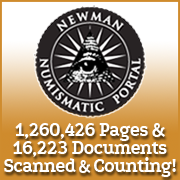
About UsThe Numismatic Bibliomania Society is a non-profit organization devoted to the study and enjoyment of numismatic literature. For more information please see our web site at coinbooks.org SubscriptionsThose wishing to become new E-Sylum subscribers (or wishing to Unsubscribe) can go to the following web page link MembershipThere is a membership application available on the web site Membership Application To join, print the application and return it with your check to the address printed on the application. Print/Digital membership is $40 to addresses in the U.S., and $60 elsewhere. A digital-only membership is available for $25. For those without web access, write to: Terry White, Treasurer AsylumFor Asylum mailing address changes and other membership questions, contact Terry at this email address: terrywhite5475@yahoo.com SubmissionsTo submit items for publication in The E-Sylum, just Reply to this message, or write to the Editor at this address: whomren@gmail.com BUY THE BOOK BEFORE THE COINSale Calendar |
- WAYNE'S WORDS: THE E-SYLUM SEPTEMBER 3, 2017
- SO-CALLED DOLLARS FEATURED IN 3RD MEGA RED
- ROOSEVELT DIME IMAGES SOUGHT
- 1862-3 LEGAL TENDER CLASSIFICATION GUIDE
- ARTIST SANDRA DEIANA DESIGNS KAGIN SALE COVER
- THE APOSTROPHE SALES: 1978-1990
- JACOB LIPSON BEGINS COIN COLUMN
- ANS LINKS LIBRARY CATALOG TO INTERNET ARCHIVE
- JOHNSON ANNOTATES EARLY U.S. MINT ACCOUNT
- MORE NEWMAN PORTAL ARCHIVAL ADDITIONS
- MORE ON THE BASHLOW KENNEDY POPE SATIRE MEDAL
- REMEMBERING CHARLES J. RICARD
- NOTES FROM E-SYLUM READERS: SEPTEMBER 3, 2017
- YOAV FARHI WINS SHEKEL PRIZE
- 'ANCIENT SHEKEL' FIND IS ONLY A FACSIMILE
- VOCABULARY TERM: INSPECTION
- JOHN BAPTIST GARDELLA (1881-1961)
- MNUCHIN MAY RECONSIDER HARRIET TUBMAN $20 BILL
- VIDEO: RESOLUTE AMERICANA CONTINENTAL DOLLARS
- COUNTERFEIT 1787 MASSACHUSETTS “4C” HALF CENT
- REBEL WON FRACTIONAL NOTE FROM GENERAL SCOTT
- NUMISMATIC NUGGETS: SEPTEMBER 3, 2017
- PAN AUCTION CLOSES OCTOBER 27, 2017
- THE FRENT POLITICAL MEMORABILIA COLLECTION
- SALEM CYPRUS BANKNOTES AT HERITAGE
- HAWAII LAHAINALUNA SEMINARY NOTES OFFERED
- 'RARE' 5-MILLION DEUTSCHMARK COIN FOUND
- SIGNEVIERISTS: FIRE MARK COLLECTORS
- THE THIRD DEGREE KNICKER PIE EATER’S CLUB
- COMMEMORATIVE COINS FOR WARTIME SEX SLAVES?
- CASH-BURNING ACTIVIST CALLS FOR END TO FRANC
- WHAT IF COMPANIES PRINTED THEIR OWN CURRENCIES?
- FEATURED WEB SITE: INTERNATIONAL BOND & SHARE SOCIETY
Click here to access the complete archive
To comment or submit articles, reply to whomren@gmail.com
Content presented in The E-Sylum is not necessarily researched or independently fact-checked, and views expressed do not necessarily represent those of the Numismatic Bibliomania Society.
WAYNE'S WORDS: THE E-SYLUM SEPTEMBER 3, 2017
 New subscribers this week include: Gilbert Chang, Dave Cross, and George Drazinakis. Welcome aboard! We now have 3,278 subscribers.
New subscribers this week include: Gilbert Chang, Dave Cross, and George Drazinakis. Welcome aboard! We now have 3,278 subscribers.
Thank you for reading The E-Sylum. If you enjoy it, please send me the email addresses of friends you think may enjoy it as well and I'll send them a subscription with your compliments.
Contact me at whomren@gmail.com anytime regarding your subscription, or questions, comments or suggestions about our content.
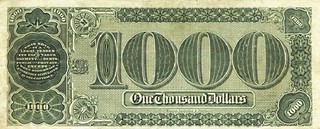
This week we open with an anniversary - our own! The e-mail newsletter we now call The E-Sylum was inaugurated with a short message on the morning of Friday, September 4, 1998. For a trip down Memory Lane, see the online archive on our web site, which holds all 999 issues and 23,235 articles published before today. Welcome to our 20th year and 1,000th issue.
Other topics this week include So-Called Dollars, Kagin’s auction cover design contest, the Apostrophe sales, Newman Numismatic Portal additions, the Shekel Prize, Collectors' Monthly publisher John Baptist Gardella, Continental dollars, early Hawaiian paper money, and the International Bond & Share Society.
To learn more about U.S. Legal Tender Notes, an 1853 visit to the U.S. Mint, the Charles J. Ricard Napoleon medal, numismatic chairs, the 1745 Lima Treasure, a counterfeit Massachusetts half cent, the Salvador Dali King David medal, Cypriot banknotes, scripophily, signevierists, and the Third Degree Knicker Pie Eater’s Club, read on. Have a great week, everyone!
Wayne Homren
Editor, The E-Sylum
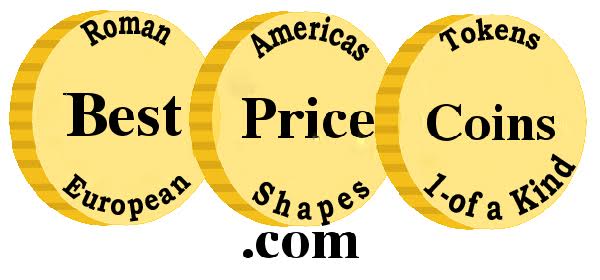
SO-CALLED DOLLARS FEATURED IN 3RD MEGA RED
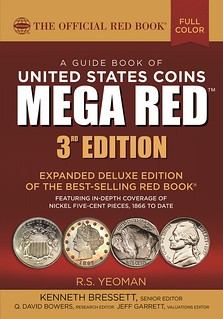 The third edition of MEGA RED (the Deluxe Edition of the Guide Book of United States Coins) includes a ten-page full-color appendix on So-Called Dollars, a class of nearly 800
different historical medals, many of them struck by the United States Mint.
The third edition of MEGA RED (the Deluxe Edition of the Guide Book of United States Coins) includes a ten-page full-color appendix on So-Called Dollars, a class of nearly 800
different historical medals, many of them struck by the United States Mint.
The section’s author, Jeff Shevlin, is a specialist in the field. He defines So-Called Dollars as “U.S. medals approximately the size of a silver dollar that were struck to commemorate a historical subject.” He notes that many of the most famous engravers of U.S. coins also engraved So-Called Dollars, including William and Charles Barber, George T. Morgan, and Augustus Saint-Gaudens. “Some of the designs and artwork on these pieces match or surpass these artists’ other work in coin and medal design,” Shevlin writes.
The medals are known as So-Called Dollars because their sizes typically range between 33 and 45 mm in diameter, similar to the silver dollar’s 38.1 mm. They were minted in many compositions and alloys, including gold, silver, copper, bronze, brass, aluminum, nickel, white metal, German silver, and gutta-percha. When composition is considered, there are more than 1,500 varieties to collect.
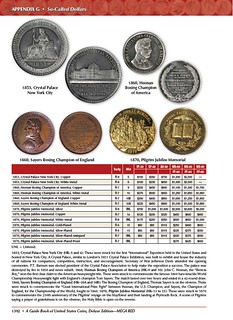 Shevlin writes that approximately half of So-Called Dollars were made to celebrate fairs and expositions (such as the World’s Columbian Exposition of 1893, held in Chicago), and the other
half to commemorate a broad range of subjects. The completion of the Erie Canal in 1826 and the Transcontinental Railroad in 1869, the centennial of the Pony Express in 1961, famous Americans,
military battles, and hundreds of other local, regional, and national subjects have been remembered with So-Called Dollars.
Shevlin writes that approximately half of So-Called Dollars were made to celebrate fairs and expositions (such as the World’s Columbian Exposition of 1893, held in Chicago), and the other
half to commemorate a broad range of subjects. The completion of the Erie Canal in 1826 and the Transcontinental Railroad in 1869, the centennial of the Pony Express in 1961, famous Americans,
military battles, and hundreds of other local, regional, and national subjects have been remembered with So-Called Dollars.
For collectors, Shevlin explores ways to assemble a specialized collection of So-Called Dollars. “Some collectors aspire to collect the entire series, and some collect specific metal compositions,” he writes. “Many collectors have an interest in one or more of the major expositions or other significant events in U.S. history. . . . Some collect medals from local or regional areas, while others have an interest in those with a U.S. Mint relationship, which includes a broad area of different designs.” He gives examples of military medals and other popular categories.
He also lays out a rarity-rating scale, ranging from R-10 (unique) to R-1 (more than 5,000 known), and notes that hundreds of So-Called Dollars can be collected for $25 to $75 each in Mint State. “One of the most common So-Called Dollars is the 1931 McCormick Reaper Centennial Dollar, of which there were possibly as many as 5,000 struck,” Shevlin writes. “Compare that to the 1909-S V.D.B. Lincoln cent, of which 484,000 were minted. While the Lincoln cent in MS-63 would sell for $1,500, the McCormick Reaper in the same grade sells for around $20 despite being 100 times rarer.” He notes that many highly desired rare varieties from the 1800s are beautiful pieces of art, struck in bronze and with high relief: “At the upper end of the So-Called Dollar market—those that sell for $1,000 or more—collectors are treated to exceptionally rare and significant pieces.”
Shevlin catalogs more than 80 individual varieties in a richly illustrated overview that includes history, photographs, and valuations in up to six grades from Very Fine to Mint State–65, plus Proofs. He starts with the 1853 Crystal Palace medal and concludes with the 1960 Boy Scouts of America 50th-Anniversary Jamboree medal.
The third edition of the 1,504-page MEGA RED officially debuted at the Whitman Coin and Collectibles Baltimore Expo, March 30, 2017. The book retails for $49.95 and is available online (including at Whitman.com) and from booksellers and hobby shops nationwide. Because Whitman Publishing is the Official Supplier of the ANA, Association members receive a 10% discount off all purchases.
MEGA RED: A Guide Book of United States Coins, Deluxe Edition, 3rd edition
ISBN 0794845096
1,504 pages, full color
By R.S. Yeoman; senior editor Kenneth Bressett; research editor Q. David Bowers; valuations editor Jeff Garrett
$49.95 retail
ROOSEVELT DIME IMAGES SOUGHT

Whitman Publishing is looking for sharp, high-resolution photographs of Roosevelt dimes, 1946 to date, including die varieties, to illustrate the fourth edition of MEGA RED (the Deluxe Edition of the Guide Book of United States Coins). Hobbyists who share their photographs will be credited in the book’s acknowledgments.
Billed as the “biggest, most useful Red Book ever,” MEGA RED measures 7 x 10 inches and has 1,504 pages. Each year’s new MEGA RED features an in-depth focus on one or more coin series.
- The first edition included a 364-page section on copper half cents and large cents, with images, history, diagnostics, and pricing for 832 die varieties.
- The second edition featured 330 pages covering 607 varieties of Flying Eagle, Indian Head, and Lincoln cents.
- The third edition featured 314 pages on America’s nickel five-cent coins (Shield nickels, Liberty Head nickels, Buffalo nickels, and Jefferson nickels), covering 545 varieties.
The fourth edition of MEGA RED will debut in March 2018. It will cover all series of United States dimes, starting with the famous disme of 1792. Q. David Bowers will share his research on Draped Bust, Capped Bust, Liberty Seated, Barber, Mercury, and Roosevelt dimes.
“We’re seeking nicely matched sets of Roosevelt dimes, including silver and copper-nickel coins, in Mint State as well as Proofs, plus the major die varieties,” said Whitman publisher Dennis Tucker. “In addition, we welcome photographs of dime-related ephemera from any era. This might include savings-bank folders, Christmas cards with openings for dimes, dime-shaped bottles, and other collectibles.”
Image files should be at least 300 dpi at two times actual size. “Scans and cell-phone photographs generally are not acceptable for this kind of cataloging,” Tucker said. “Ideally we’d like to see collectors’ best professional-level photography.”
Hobbyists with images to share should contact Dennis Tucker at dennis.tucker@whitman.com by October 27, 2017.
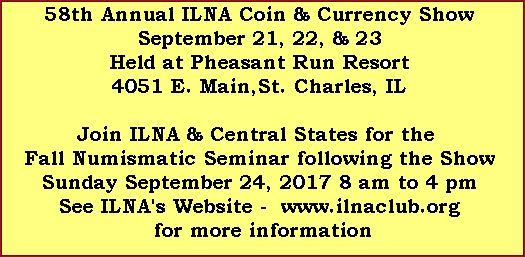
1862-3 LEGAL TENDER CLASSIFICATION GUIDE
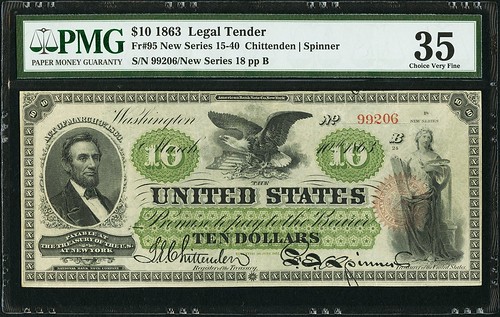
The most difficult large size United States type notes to classify by Friedberg number are the 1862-3 Legal Tender notes. Vexing is that the diagnostics used to discriminate between the multitude of varieties are subtle and confusing. Adding to the confusion is that the ad hoc Friedberg numbers that were assigned to them are not in chronological order because many of those numbers were assigned in the order in which the varieties were discovered.
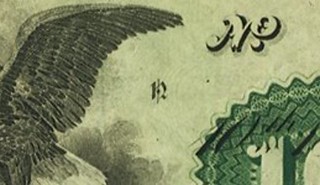 Peter Huntoon worked with Doug Murray to develop a spreadsheet that lists every diagnostic for every issued variety in order to allow anyone to easily determine the correct Friedberg number
for any of these notes.
Peter Huntoon worked with Doug Murray to develop a spreadsheet that lists every diagnostic for every issued variety in order to allow anyone to easily determine the correct Friedberg number
for any of these notes.
Eventually this spreadsheet will be published with an article showing photos of the diagnostics. In the meantime those of you who work with these notes will find this spreadsheet to be self-explanatory and helpful.
To access the Guide on the Newman Portal, see:
Atrribution Guide to 1862 & 1863 Legal Tender Notes (https://nnp.wustl.edu/library/book/535246)

ARTIST SANDRA DEIANA DESIGNS KAGIN SALE COVER
26 Year Old Italian Artist Wins Latest Kagin’s Auctions Cover Design Contest
 Sandra Deiana of Rome, Italy is the winner of the second Kagin’s Auctions Cover Design Contest and a one ounce gold American eagle. “Her stunning depiction of America’s $10 Indian princess
with coins emanating from her headdress is unique,” Observed, Don Kagin, president of Kagin’s Auctions who sponsored the contest for their West Coast Auction to be held September 15th in conjunction
with the Santa Clara Expo at the Santa Clara, CA. Convention Center.
Sandra Deiana of Rome, Italy is the winner of the second Kagin’s Auctions Cover Design Contest and a one ounce gold American eagle. “Her stunning depiction of America’s $10 Indian princess
with coins emanating from her headdress is unique,” Observed, Don Kagin, president of Kagin’s Auctions who sponsored the contest for their West Coast Auction to be held September 15th in conjunction
with the Santa Clara Expo at the Santa Clara, CA. Convention Center.
The composition is in colored pencil on paper with images enhanced digitally.
Ms. Deiana is a student at the School of Art and Medal Making at the Italian Mint. She was the second place (back cover design) winner for the inaugural Kagin’s Cover Design Contest for the American Numismatic Association National Money Show Auction. Second place and back cover placement went to designer and photographer Steve Heriot for his exquisite watercolor composition.
As part of the Kagin’s Auctions Cover Artist Series, entries for the next contest will be accepted starting in January, 2018 for the ANA National Money Show Auction March 10th in Dallas, Texas.
The unreserved West Coast auction is available online at www.Kagins.com and free catalogs, which will include hundreds of California pioneer gold, shipwreck coinage, copper, silver and gold U.S. coins, patterns and medals and Hobo nickels are available from info@kagins.com or call 888-8kagins (852-4467).
To read the earlier E-Sylum articles, see:
KAGIN’S ANNOUNCES CATALOG COVER CONTEST WINNER (http://www.coinbooks.org/v20/esylum_v20n06a07.html)
KAGIN’S AUCTIONS INTRODUCES ARTIST SERIES (http://www.coinbooks.org/v20/esylum_v20n16a08.html)
THE APOSTROPHE SALES: 1978-1990
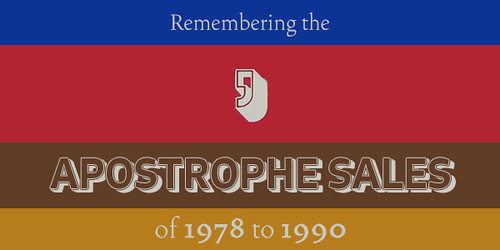
Resentment over the early departure of bourse dealers reached a peak in Atlanta, when outspoken incoming president Criswell and his then-ally John J. Pittman walked the bourse floor with clipboards, jotting down the names of offending dealers. Soon after the show closed, the two raised the early departure issue before the new board and engineered the denial of tables at the 1978 Houston convention to five offending firms.
These included Stack’s of New York; Bowers & Ruddy of Los Angeles; Rarcoa of Chicago; Paramount International of Englewood, Ohio; and Superior Stamp and Coin, also of Los Angeles. These also happened to be the leading numismatic firms in the entire U.S. Despite a gleeful “we showed ‘em” attitude among ANA board members, the absence of these major dealers would notably impact the Houston convention’s bottom line.
But more than that, the action against these dealers had the wholly unexpected consequence of bringing them together for the first time in numismatic history to collaborate in staging an annual series of auctions that became known as the Apostrophe Sales based on their names: Auction ’79 through Auction ’90. These cooperative sales gave forthright competition to the official ANA convention auctions and were bitterly opposed by such ANA leaders as John J. Pittman.
Establishing cooperation among competing dealers was no easy task, though ground rules were relatively simple. Free of the staggering or extortionate fees demanded by the ANA for the convention sale, each firm would place 500 high-quality lots in their section of each Apostrophe sale. Each would catalog its section in its own customary style and provide color and black-and-white photography. All catalogs would be produced by a single printer and would be distributed in hard cover or paperback format.
To read the complete article, see:
Coin Market In-Depth: Remembering the Apostrophe Sales: 1978-1990
(http://www.coinweek.com/us-coins/coin-market-in-depth-remembering-the-apostrophe-sales-1978-1990/)

JACOB LIPSON BEGINS COIN COLUMN
 I have been working as a professional numismatist for nearly eight years now, starting out as a dealer in a small coin shop in my hometown of Montreal, Quebec. I worked there buying,
selling, and appraising coins for four years while pursuing my studies.
I have been working as a professional numismatist for nearly eight years now, starting out as a dealer in a small coin shop in my hometown of Montreal, Quebec. I worked there buying,
selling, and appraising coins for four years while pursuing my studies.
In 2014, I completed an internship as a United States coin cataloguer for Heritage Auctions in Dallas, Texas. My job was to learn how to evaluate, research, and write about some of the most important (read: expensive) U.S. coins.
At the end of my stage, my boss asked if I would stay on in my role as a cataloguer while working remotely from home. So, I have spent the past three years working with some of the foremost experts for the third-largest auction house in the world, and the largest dealer in rare coins.
In addition to my work for Heritage, I continue to trade in coins and paper money, setting up and local and national coins shows, and helping individuals and families appraise and liquidate their holdings.
Finally, I am a member of various professional organizations, including the Royal Canadian Numismatic Society, American Numismatic Association, and Montreal Numismatic Society.
Now that we have gotten that out of the way, let me outline what I hope to achieve with this column. First and foremost, I hope to help you, the reader, learn more about collecting coins. In my experience, most people also have some cache of coins they want to learn more about – whether it be their history or value.
Future articles will tackle a variety of subjects like what makes a coin valuable, the importance of condition, coins as investments, and cleaning your coins (hint: don’t).
What excites me most about this new column is the opportunity to take your questions. Every week, I hope to answer one or two inquiries. Readers can send questions and comments to my email address j.lipson@hotmail.com, or Dawson Creek Mirror Editor Rob Brown at editor@dcdn.ca.
To read the complete article, see:
DC Coin expert Jacob Lipson joins the Mirror team as a
columnist (http://www.dawsoncreekmirror.ca/opinion/columnists/dc-coin-expert-jacob-lipson-joins-the-mirror-team-as-a-columnist-1.22208101)
THE BOOK BAZARRE
ANS LINKS LIBRARY CATALOG TO INTERNET ARCHIVE
American Numismatic Society Links Library Catalog to Internet Archive scans
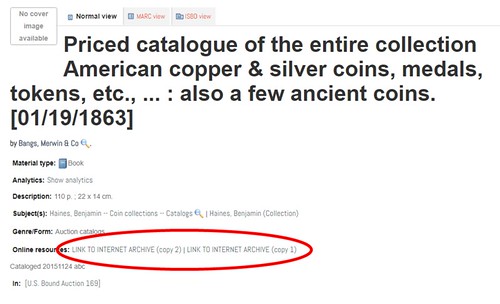
Sponsored by the Newman Numismatic Portal, over 4,300 documents in the American Numismatic Society (ANS) library have been digitized since November 2015. In addition to being accessible on the Newman Numismatic Portal, these documents are now also available via the ANS online library catalog, DONUM. Library patrons using DONUM will now see “online resources” in the library catalog description, which users may select to be redirected to the scanned document on Internet Archive.
Scanning at the ANS has focused on 19th century and early 20th century American numismatic auction catalogs, and in many cases, duplicate examples exist in the ANS collection, often with unique annotations. DONUM notes this as “link to copy 1,” “link to copy 2,” etc., so that all copies may be accessed by the user. This project was facilitated by David Hill (ANS Librarian), Tomas Arazi (DONUM programmer), Len Augsburger (Newman Portal Project Coordinator), and Jake Johnson (Internet Archive), who oversees the Internet Archive API.
Link to DONUM citation with multiple linked copies (1863 Haines auction sale catalog):
http://donum.numismatics.org/cgi-bin/koha/opac-detail.pl?biblionumber=274

JOHNSON ANNOTATES EARLY U.S. MINT ACCOUNT
D. Wayne Johnson Annotates Early U.S. Mint Account
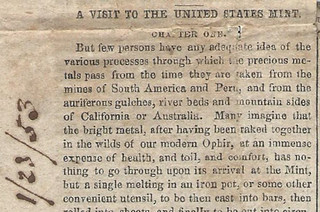 The mid-19th century era is a fertile ground for numismatic research. Few dedicated numismatic publications exist, and authors published in whatever venues were available. This produced
numerous needles in haystacks, as numismatic information might be buried almost anywhere. Eric P. Newman recalled a thorough search of 1830s anti-slavery periodicals, often religious in nature, for
mentions of anti-slavery tokens. “I read so many of them I nearly turned fundamentalist,” Newman observed. Researchers of Newman’s era all had similar experiences.
The mid-19th century era is a fertile ground for numismatic research. Few dedicated numismatic publications exist, and authors published in whatever venues were available. This produced
numerous needles in haystacks, as numismatic information might be buried almost anywhere. Eric P. Newman recalled a thorough search of 1830s anti-slavery periodicals, often religious in nature, for
mentions of anti-slavery tokens. “I read so many of them I nearly turned fundamentalist,” Newman observed. Researchers of Newman’s era all had similar experiences.
Dick Johnson has happily transcribed and annotated one such resource, a series of articles in the Philadelphia Dispatch from 1853 that contained a lengthy description of the workflow of the U.S. Mint. At the time, this was the most extensive such description that had been published. In addition to a firsthand account of the technical operation, the writer also included, almost verbatim, certain historical information from the Pittsburgh Morning Chronicle of December 12, 1843. The Dispatch article further closely echoes parts of the John McAllister memorandum, prepared by McAllister following a meeting with Adam Eckfeldt on April 9, 1844. This attests to the unnamed writer’s connections, as only a few in Philadelphia would have been aware of these two sources.
Link to The Way to Make Money on the Newman Portal:
https://nnp.wustl.edu/library/book/535296
MORE NEWMAN PORTAL ARCHIVAL ADDITIONS
Information Is Where You Get It
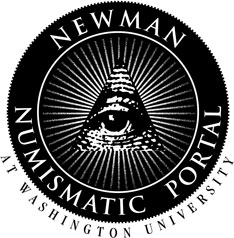 As collectors we gather information about our coins from a multitude of sources, and all of these play a different role in the collecting experience. Collectors chasing coins on a bourse
floor deal with much data that is never recorded and only orally shared between collectors and dealers. Who owns what? Who needs what? Which dealer has a buyer lined up for the coin I want to sell?
How strong or weak is the market? The answers to such questions constantly change, and are best learned by maintaining a level of engagement with dealers and other collectors.
As collectors we gather information about our coins from a multitude of sources, and all of these play a different role in the collecting experience. Collectors chasing coins on a bourse
floor deal with much data that is never recorded and only orally shared between collectors and dealers. Who owns what? Who needs what? Which dealer has a buyer lined up for the coin I want to sell?
How strong or weak is the market? The answers to such questions constantly change, and are best learned by maintaining a level of engagement with dealers and other collectors.
As project coordinator of the Newman Numismatic Portal I am more focused on written materials and am constantly adding new resources to what is now the largest online American numismatic library. In addition to published materials we’ve also pursued archival sources and I’m excited about our content from the U.S. National Archives. Heretofore, the effort required to access this material was substantial – one needed to travel to a distant city and visit their facilities during normal business hours. Documents had to be called for, read, and copied for later study. Repeat visits were often needed as one learned where the more useful documents were located in the archival collection. The Newman Portal now includes approximately 50,000 pages of such material, much of it scanned under the direction of R. W. Julian (working under a grant from the Central States Numismatic Society). More recently, Roger W. Burdette has been contributing scans from Branch Mint correspondence for the 1830s and 1840s.
The branch Mint correspondence is fertile ground, and if you are so minded, I encourage a few hours browsing these 19th century ledgers. The handwriting is generally legible and usually not difficult to decipher – though I do recommend a large monitor and use of full-screen mode. You’ll get a good feel for what the Mint and Treasury department considered important at the time. Interestingly, this doesn’t always intersect with our modern concerns. The LSCC and its members have devoted tremendous study to die varieties and progressions and, in truth, we know much more about die varieties than the coiners who actually manufactured these objects. Mint officials at the time were more concerned with die preparation and shipment than in keeping track of which dies were paired in a given year – in other words, they cared more about steady production and the daily demands of a coinage factory.
Other concerns included gold production, administration of annual assays, Mint personnel, and occasional emergencies such as the yellow fever that plagued New Orleans throughout the 19th century.
These archival materials are in handwritten form, and will perhaps be transcribed in the future, although the sheer quantity necessitates a good deal of time and effort. Electronic transcriptions may eventually assist with this task. For now, we are living in an in-between period where one can view original documents online, and that is an important first step. Archives won’t tell you the difference a Fine-12 and Fine-15 Liberty Seated quarter dollar but they can make your collecting experience richer, particularly if you already have an interest in the why of coins and wish to dig deeper.
To visit the Newman Numismatic Portal, see:
https://nnp.wustl.edu
To view the referenced National Archives volumes, see:
U.S. National Archives (Record Group 104, Entry 216, Letters Received from Branch Mints and Assay Offices, 1834-1873)
(https://nnp.wustl.edu/library/archivedetail/520560)
For more information on Liberty Seated Collectors Club (LSCC), see: http://www.lsccweb.org/
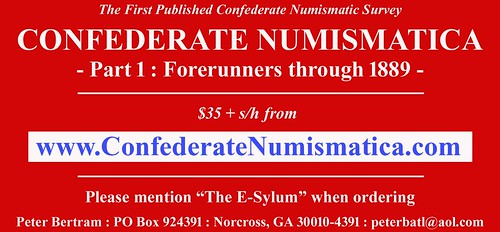
MORE ON THE BASHLOW KENNEDY POPE SATIRE MEDAL
Regarding the Kennedy-Pope satire item discussed last week, a reader writes:
The In the Pope We Hope tokens were given out by Robert Bashlow in 1961. Bashlow was an odd duck with many unusual connections. I have often wondered about the prescient 1963 date on the tokens. When asked in 1961 Bashlow would not give a reason. Bashlow had a lot of weird connections and operated in secret for much of the time.
Tony Terranova of New York City writes:
I have one of these in copper.
Another reader writes:
I believe Ed Rochette listed the 'In the Pope We Hope' medal in his catalog of JFK tokens and medals. I have one in silver and believe the mintage was around 75 in that medal but no longer have Ed's book to verify. Maybe a Numismatist article as well? This of course can be complete wrong attribution but I do have one.
Dick Johnson writes:
Ed Rochette listed this medal in his 1966 catalog of John F. Kennedy medals. It is his catalog #K-S-2b with 3 struck in gold. It was also struck in silver, 45 made, and 1,200 in bronze. They were struck in London by John Pinches. He priced the bronze at $5, the silver at $20, the gold was unpriced.
Rochette also listed a satire Washington quarter which was coated with red nail polish forming a Papal hat and cloak of Washington’s portrait. Both items express the concern of political activists that Kennedy, as U.S. President, would take orders from the Pope. Of course Kennedy won the presidency despite this group’s actions.
Ed Rochette is Catholic, Bashlow had no religion. Rochette did not take kindly to Bashlow’s anti Pope medal. To his credit Ed listed the medal in his catalog -- because it existed -- but had some comments about these two satirical pieces:
“Satirical pieces have no place in a book on coins, medals and tokens struck in memory of a martyred president And yet are listed [because they exist]... To acknowledge that these exist seems to admit that there are some who are bigoted. ..."
Dennis Tucker of Whitman Publishing writes:
Whitman Publishing associate editor Brandon Hall wrote a feature on that mysterious Kennedy medal mentioned in the last E-Sylum.

In September 2014, Whitman Publishing introduced The Kennedy World in Medallic Art: John F. Kennedy and His Family in Medals, Coins, Tokens, and Other Collectibles, by William R. Rice. Rice is respected as a well-renowned Kennedy historian and his text shines a light on the more personal aspects of the life of President John F. Kennedy and his family. While President Kennedy is widely considered one of the most beloved presidents of the United States, he also managed to strike a nerve among some American Protestants given that he was the first Roman Catholic president. In The Kennedy World in Medallic Art, Rice highlights one of the controversial medals that the enigmatic entrepreneur Robert Bashlow crafted to possibly capitalize on the anti-Catholic sentiment of the time.
Robert Bashlow was known as a rather eccentric figure who financed many interesting and sometimes obscure projects. His endeavors in numismatic publishing are well established as he was close to coin historian Walter Breen. Rice describes that Mr. Bashlow possessed a wide range of interests, as he was also known for his published works which focused on the Vietnam War, music, and sexuality. Bashlow also had a rather tumultuous personal life and he was eventually evicted from his New York Riverside Drive apartment for fighting with his landlord and failing to make rent payments on time. Unfortunately, in July 1979, the New York Times reported that Mr. Bashlow was one of 80 people who perished in a fire at the Coronade Aragon Five Star Hotel in Zaragoza, Spain. The fire started as a result of a pastry machine exploding in the kitchen.
One of the legacies that Bashlow left behind was a Kennedy medal that is thought by Rice to be a practical joke, given his colorful history. Bashlow’s 32 millimeter satirical John F. Kennedy medal was struck in London, England, by the John Pinches Ltd. Co. and is available in bronze, silver, and gold mintages — the latter of which is reported to be held in the Smithsonian Museum. While the medal was produced in 1961 and sold by the Robert Bashlow Co. Inc. in New York City, its date reads 1963 on the obverse. Rice elucidates that the reason for this is because the common thought of the time was that by the end of Kennedy’s first term, the Catholic Church would be in total control of American politics.
While the satirical anti-John F. Kennedy medal certainly pushes boundaries, it is still a piece of history that symbolizes the turbulence of early-1960s America. The medal boasts a personality of wry wit and satire befitting its creator, Robert Bashlow, who will perhaps always be remembered as one of the most infamous numismatic entrepreneurs in American history.
To read the complete article, see:
Bashlow’s satirical anti-Kennedy medal highlighted in The Kennedy World in
Medallic Art (http://news.coinupdate.com/bashlows-satirical-anti-kennedy-medal-highlighted-in-the-kennedy-world-in-medallic-art/)
To read the earlier E-Sylum articles, see:
NEW BOOK: THE KENNEDY WORLD IN MEDALLIC ART (http://www.coinbooks.org/esylum_v17n37a07.html)
NUMISMATIC NUGGETS: AUGUST 27, 2017 : Bashlow Kennedy Pope Satire Medal (http://www.coinbooks.org/v20/esylum_v20n35a23.html)
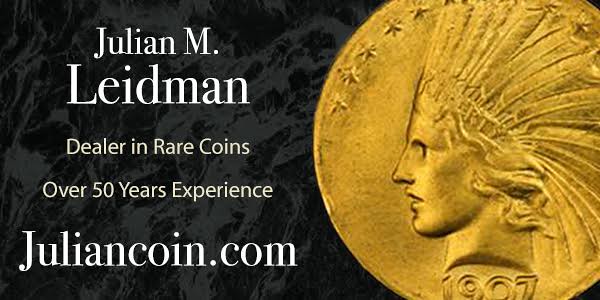
REMEMBERING CHARLES J. RICARD
Donn Pearlman writes:
I was saddened, but also enjoyed reading, the info about Charles Ricard who I met through Chicago Coin Club meetings.
David T. Alexander writes:
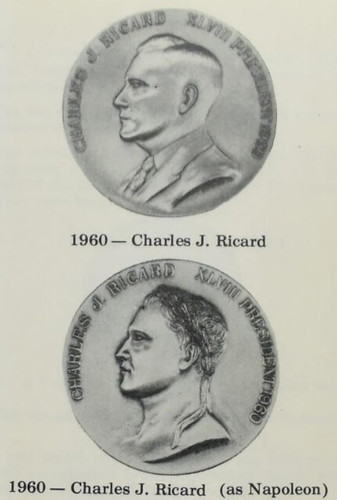 I was sorry to learn of the passing of Charles Ricard, long a stalwart of the Rochester Numismatic Association and Chicago Coin Club (RNA). The Rochester group (founded 1912) has maintained
an unbroken line of Presidential portrait medals since its beginning. As a younger collector these introduced me to Ricard.
I was sorry to learn of the passing of Charles Ricard, long a stalwart of the Rochester Numismatic Association and Chicago Coin Club (RNA). The Rochester group (founded 1912) has maintained
an unbroken line of Presidential portrait medals since its beginning. As a younger collector these introduced me to Ricard.
Someone had done a story on the series for the TAMS Journal with plate pages illustrating the types. Each medal bore a bust in business suit with each president's name, including CHARLES J. RICARD. The next cut presented the same portrait but now undraped and laureate with cutline CHARLES J. RICARD AS NAPOLEON! This was heart-stopping and I spent decades trying to find a specimen of this fantastic tribute. Alas, I was introduced decades later to Ricard himself, who revealed that there was only ONE such medal in existence, made by a talented engraver for some of his numismatic friends in recognition of his achievements as a student and collector of Napoleonic material. Ah, well!
To read the complete TAMS article on the Newman Numismatic Portal, see:
TAMS Journal, Vol. 13, No. 4 Part II
TAMS Journal, Token and Medal Society (1973) (https://nnp.wustl.edu/library/book/525686?page=10)
To read the earlier E-Sylum articles, see:
EDWIN J. REITER (1938-2017) (http://www.coinbooks.org/v20/esylum_v20n35a06.html)
CHARLES J. RICARD (1930-2017) (http://www.coinbooks.org/v20/esylum_v20n35a05.html)
Over the years I have visited Chicago a number of times. In the 1980s particularly, I have fond memories of numismatic books and libraries acquired there and even more so, of the fascinating people who owned them.
On one early visit I visited Charles Ricard at his invitation. If memory serves, the main purpose of the trip was to secure the substantial library formed by Col. H.D. Davidson. That accomplished, I did visit and purchase some books from Charles, but mostly I remember his gracious hospitality… and an intricately carved antique Asian wooden chair. I guess I have a thing about numismatic chairs (in New Jersey, I bought and still have an adjustable wooden stool branded on the bottom: H.E. DEATS). The Asian chair was beautiful but its former owner is what impressed me. Charles Ricard’s roots were in upstate New York, long a hotbed of numismatic activity. Charles was close with Syracuse numismatist and coin dealer George J. Bauer and it was his (famous to me) keister that once occupied it.
On another Chicago trip I obtained for sale the magnificent numismatic library formed by Michael A. Powills, an early highlight of my career. During this period, a visit with another well-known Chicago area collector, Chester Poderski, was also memorable on two fronts: a substantial mid-day meal graciously prepared from scratch by his 90+ year-old mother (T-bone steak with all the fixings and homemade apple pie for dessert), followed by Chester proudly showing me his many hidey holes throughout the old three story house (Morgan dollars here, bullion there, rare coins everywhere). I even bought a few books.
Sorry to ramble but Chicago is a wonderful numismatic city (a later visit to the Rarcoa library, with Myron Xenos, is another fond memory). Anyway, Charles Ricard and I both attended nearly all of the ANA conventions from the late 70s onward (Charles attended many before then). Most years we ran in to each other and shared a pleasant conversation. Charles J. Ricard was a gentleman of the old school. His love of numismatics and its literature was infectious and enduring. I was honored to have known him.

NOTES FROM E-SYLUM READERS: SEPTEMBER 3, 2017
On Japanese Books
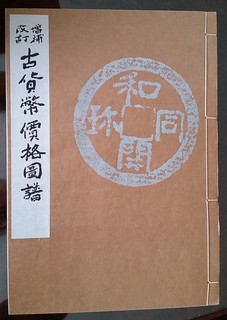 Regarding Lee Toone's question about a book on Japanese coins, Martin Purdy of New Zealand writes:
Regarding Lee Toone's question about a book on Japanese coins, Martin Purdy of New Zealand writes:
I don't recognise this particular book but it looks like a typical Japanese binding, similar to one I picked up when I lived there in 1986-87 (photos attached). The 3rd and 4th images in the article are upside down, however - Japanese books traditionally have the spine at the right and open from what looks like the back page to us. It's less common now but older books were done that way. Mine was printed in 1974 but done the old way, for whatever reason. A couple of pictures from the one I bought are attached. The paper is the same too - each page is a double leaf, uncut.
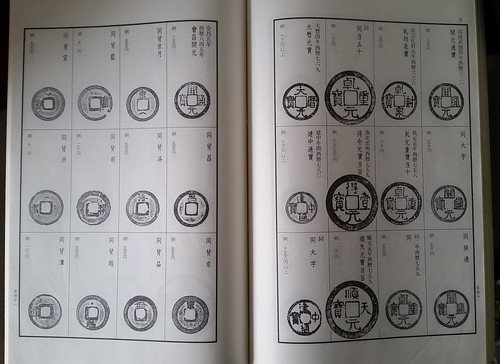
To read the earlier E-Sylum article, see:
QUERY: BOOK ON JAPANESE COINS (http://www.coinbooks.org/v20/esylum_v20n35a11.html)
More on the 1745 Lima Treasure
Eric Hodge writes:
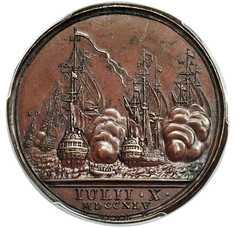 I was pleased to see you highlight the 1745 Lima Treasure Captured medal. In so many numismatic publications the mark LIMA that is found on some George II silver of 1745 and 1746 is noted
as indicating silver captured by Admiral Anson during his circumnavigation of the globe and subsequent capture of a Spanish treasure galleon. The most recent I have seen was in Coin World for
December 2016.
I was pleased to see you highlight the 1745 Lima Treasure Captured medal. In so many numismatic publications the mark LIMA that is found on some George II silver of 1745 and 1746 is noted
as indicating silver captured by Admiral Anson during his circumnavigation of the globe and subsequent capture of a Spanish treasure galleon. The most recent I have seen was in Coin World for
December 2016.
I believe this to be incorrect and this medal illustrates the alternative theory, which is in fact supported by original documentation. For anyone interested they cannot do better than read the excellent article by Harry Apling published in the Seaby Coin & Medal Bulletin for March 1970 pages 82-87. I enclose a copy for easy reference.
Thank you, again, for all your hard work. I have particularly been interested in your recent references to Coin Digit Image databases.
To read the earlier E-Sylum article, see:
NUMISMATIC NUGGETS: AUGUST 27, 2017 : 1745 Lima Treasure Captured Medal (http://www.coinbooks.org/v20/esylum_v20n35a23.html)
Ft. Knox Politics
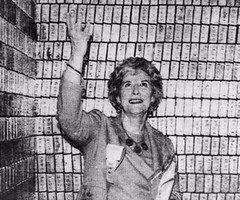 A reader inquired about the political tone of last week's Ft. Knox article. While we veer away from politics as much as possible, it's often necessary to provide context to a
numismatic issue, which in this case was the earlier Ft. Knox visit by U.S. Mint Director Mary Brooks, as recounted in the quoted Coin World article. The political push behind her 1974 visit
was the same as Mnuchin's 40 years later - worries that the nation's gold reserve had been raided by earlier administrations. This time, as before, those rumors were put to rest.
A reader inquired about the political tone of last week's Ft. Knox article. While we veer away from politics as much as possible, it's often necessary to provide context to a
numismatic issue, which in this case was the earlier Ft. Knox visit by U.S. Mint Director Mary Brooks, as recounted in the quoted Coin World article. The political push behind her 1974 visit
was the same as Mnuchin's 40 years later - worries that the nation's gold reserve had been raided by earlier administrations. This time, as before, those rumors were put to rest.In today's issue we have at least three numismatic stories driven by politics - the Kennedy "In the Pope We Hope" medal, the on again/off again plan to put Harriet Tubman on a banknote, and the burning in protest of a banknote in Senegal. Numismatics doesn't exist in a vacuum, and we have to acknowledge political thought even as we steer clear of taking sides (as in the Ft. Knox piece, where concerns of both major parties were acknowledged). -Editor
To read the earlier E-Sylum article, see:
CIVILIAN DELEGATION VISITS FT. KNOX (http://www.coinbooks.org/v20/esylum_v20n35a21.html)
Kudos from a New Reader
New reader David Strange writes:
Love the emails. Educational, interesting, humor....something for everyone.
Elysium
Jeff Reichenberger of Oshkosh, WI writes:
I recently discovered the word Elysium. At first glance I naturally thought it was Esylum. I was mistaken…or was I? Upon learning the definition of Elysium – “any place or state of perfect happiness” – one might consider them synonyms.
Definition of Elysium
1: the abode of the blessed after death in classical mythology
2: paradise
Did You Know?
This word came into Latin from the Greek Elysion. In classical mythology, Elysium, or the Elysian fields, was the home of the blessed after death, the final resting place of the souls of the heroic
and the pure. So it's easy to see how the word came to mean any place or state of bliss or delight. When we try to picture heaven, many of us probably see a lovely park; the great boulevard of
Paris was named for the beautiful park that originally bordered it: the Champs-Elysées, or Elysian Fields.
To read full definition, see:
Elysium (https://www.merriam-webster.com/dictionary/Elysium)
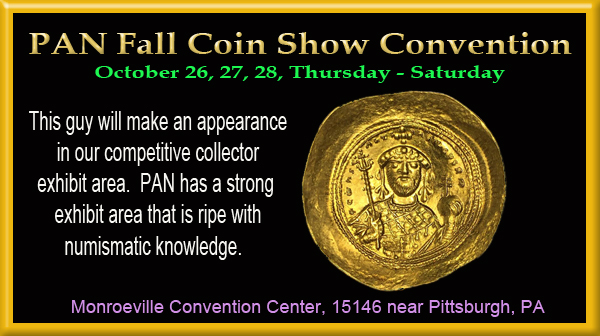
YOAV FARHI WINS SHEKEL PRIZE
The Board Of Directors of the American Israel Numismatic Association has created the Shekel Prize, that will be given annually to the author of the best book published on the subject of Ancient Judaean, Holy Land, Israel, or Jewish Numismatics. The judging committee consists of Mel Wacks, David Hendin, Ira Rezak, Steve Album and Allen Berman.
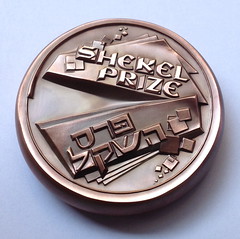
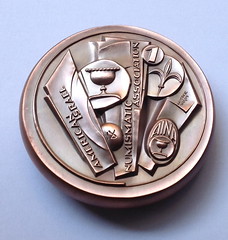
The Shekel Prize is an extremely high relief 3-inch medal designed by Victor Huster. Featured are three shekel designs—from a c. 8th century BCE shekel stone weight, a shekel of the First Revolt (66-70 CE), and 1-new shekel (issued by Israel beginning in 1985).
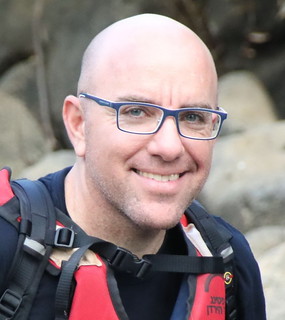 The first winner is Yoav Farhi, author of “Khirbet Qeiyafa Vol. 5: Excavation Report 2007–2013, The Numismatic Finds: Coins and Related Objects.” Other contributors to this volume
are C. Lorber, S. Shalev and S. Shilstein. The Shekel Prize medal will be presented to Yoav later this year in a ceremony in Israel.
The first winner is Yoav Farhi, author of “Khirbet Qeiyafa Vol. 5: Excavation Report 2007–2013, The Numismatic Finds: Coins and Related Objects.” Other contributors to this volume
are C. Lorber, S. Shalev and S. Shilstein. The Shekel Prize medal will be presented to Yoav later this year in a ceremony in Israel.
This is Farhi’s first book. His MA thesis (2004) was The Coinage of the City of Lod (Diospolis) from the Roman Period to the End of the Early Islamic Period (Hebrew), and Farhi’s Doctoral Dessertation (2013) was The Coinage of Gaza in the Roman Period (1st Century BCE-3rd Century CE).
The winning book’s content is described by the publisher, The Israel Exploration Society:
More than 600 coins and related objects were found at Khirbet Qeiyafa during the 2007–2013 excavation seasons. The earliest coins date from the end of the sixth century BCE and the latest from the British Mandate. These coins almost all relate to three phases in the history of the site following the Iron Age occupation: the Late Persian–Early Hellenistic period (late fourth–early third centuries BCE), the Hasmonaean period up to the destruction of the Second Temple (first century BCE–first century CE) and the Late Roman and Byzantine periods (fourth–fifth centuries CE).
The numismatic finds from the Late Persian–Early Hellenistic period are extraordinary in their amount and rarity and include many types that were hitherto unknown from controlled excavations. The variety of coins that were found – imported Archaic and Classical Greek coins, coins from Phoenicia, local coins from mints in Jerusalem, Philistia, Samaria and possibly Edom, as well as Macedonian and Ptolemaic coins – contributes a great deal to our knowledge of the monetary economy of Judaea and its neighbours during the transition from the Persian to the Hellenistic period.
The exposure of this stratum and its numerous small finds is of great significance for the study of the transition from the Persian to the Hellenistic period in this region, since no site exposed so far in Israel in general, or in this region in particular, contains a comparable single-period occupation stratum that can be so precisely dated to this period.
Other publications in the running for the 2017 Shekel Prize were “Jewish History in the Bible Portrayed in Coins” by Dr. John G. Leslie and “The New York Sale Auction XXXIX of Ancient Coins Featuring The Brody Family Collection of Ancient Jewish Coins” cataloged by Ira & Larry Goldberg Auctioneers, Baldwin’s, Dmitry Markov, and M & M Numismatics Ltd.
Mel adds:
By the way, I believe that I learned about Yoav's book from The E-Sylum!
'ANCIENT SHEKEL' FIND IS ONLY A FACSIMILE
Regarding the coin found by an Israeli girl discussed last week, David Hendin writes:The girl who found the ancient shekel--the coin wasn't even a forgery - it was a one sided facsimile made at a summer crafts program at the Israel Museum in Jerusalem.
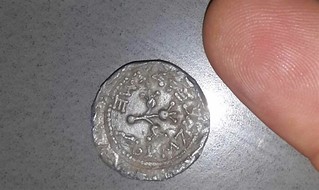 The Times of Israel reported that it was alerted Sunday morning that the coin found by the girl is actually a coin created on a small mint in the Youth Wing of the Israel Museum, an annual
project for children during yearly Hanukkah activities at the museum. One side of the coin is left blank so that it will not be mistaken for a real coin, according to the report.
The Times of Israel reported that it was alerted Sunday morning that the coin found by the girl is actually a coin created on a small mint in the Youth Wing of the Israel Museum, an annual
project for children during yearly Hanukkah activities at the museum. One side of the coin is left blank so that it will not be mistaken for a real coin, according to the report.
Dr. Haim Gitler, chief curator of Archaeology and the curator of Numismatics at the Israel Museum called the Times of Israel to inform it of the mistake, the news website reported.
“There is no chance that it is authentic, it is not an ancient coin. Even to call it a coin is to exaggerate what it is,” Gitler told the Times of Israel, adding that the markings on the “artifact” discovered by the girl are 100% identical to the mold at the museum. “Whether it was 2016 or 2015, that’s more the question,” he also said.
The archaeological unit of the army’s Civil Administration unit, or COGAT, currently is possession of the coin. Its authenticity or lack of authenticity still will have to be officially verified, according to the report.
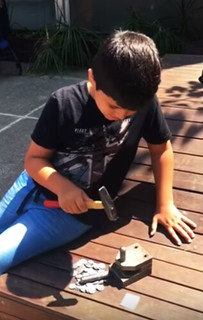 To read the complete article, see:
To read the complete article, see:
Is this 'ancient' coin from 2015 or 2016? (http://www.israelnationalnews.com/News
/News.aspx/234643)
Aaron adds:
And here's a video of the actual "minters" at work! I personally found it to be a wonderful way of introducing the coin minting process to youngsters.
To watch the complete video, see:
Children create 'ancient coins' at the Israel Museum, August 2017 (https://www.youtube.com/watch?v=46n4Fwjwf9E)

For more than 20 years, children visiting the Israel Museum in Jerusalem during the winter festival of Hanukkah have had the opportunity to go home with an “ancient” coin. Struck by the kids on a small mint in the museum’s Youth Wing, the souvenir is an exact, albeit one-faced, replica of an ancient coin.
Perhaps too exact, it turns out.
International media, including this journalist at The Times of Israel, reported last week on the find of a rare 2,000-year-old half-shekel by 8-year-old Halamish girl Hallel Halevy. It turns out that this “coin,” far from being ancient and significant, is one of tens of thousands of these one-faced souvenirs minted at the Israel Museum over the past two decades.
The Times of Israel was alerted to the misidentification on Sunday morning by Dr. Haim Gitler, chief curator of Archaeology and the curator of Numismatics at the Israel Museum.
To read the complete article, see:
Too good to be true: 8-year-old’s ‘rare coin’ not an ancient artifact
(http://www.timesofisrael.com/too-good-to-be-true-8-year-olds-rare-coin-not-an-ancient-artifact/)
A 2,000-year-old coin promoted by Israeli Prime Minister Benjamin Netanyahu as proof of the Jewish people's connection to the Israeli-controlled West Bank has been found to be a souvenir reproduction.
"This exciting discovery is additional evidence of the deep connection between the people of Israel and its land - to Jerusalem, to our temple, and to the communities in Judea and Samaria," Netanyahu said of the coin on Facebook Sunday, using the biblical Hebrew term for the West Bank.
Ancient discoveries are not uncommon in Israel and the West Bank. Earlier this month, Israeli authorities uncovered a 2,000-year-old workshop for stone vessels in northern Israel. But this "discovery," first reported by Israeli media, turned out to be one of thousands of cheap souvenir coins minted by the Israel Museum.
The post was deleted on Monday from Netanyahu's Facebook page.
To read the complete article, see:
Israel's Netanyahu uses fake '2,000-year-old'
coin to justify settlements in West Bank (https://www.dailysabah.com/mideast/2017/08/28/israels-netanyahu-uses-fake-2000-year-old-coin-to-justify-settlements-in-west-bank)
To read the complete articles, see:
Discovery believed to be Second
Temple coin reportedly is Israel Museum souvenir
(http://www.jta.org/2017/08/27/news-opinion/israel-middle-east/discovery-believed-to-be-second-temple-coin-is-actually-israel-museum-souvenir-report-says)
SECOND TEMPLE COIN DISCOVERY IS ACTUALLY MUSEUM SOUVENIR
(http://www.jpost.com/Israel-News/Discovery-thought-to-be-Second-Temple-coin-is-actually-museum-souvenir-503592)

VOCABULARY TERM: INSPECTION
Inspection. Examination for flaws which can occur at any step of the manufacturing process. There are three kinds of flaws which inspectors must look for: planchet flaws, striking flaws and finishing flaws. Inspectors of coins are concerned with only the first two, medal inspectors must be aware of all three. Planchet flaws consist of oversize, undersize, thick, thin, wrong metal, clipped and damaged planchets. Striking flaws consist of weakly struck, double struck, multiple struck, multiple planchet, rotated dies, off center, impressed errors, clashed dies and incorrect mating of obverse and reverse dies. Finishing flaws consist of stains, discolorations, damage due to mishandling (edge nicks, holes, mashed or damaged lettering) and incorrect serial numbers. Careful inspection is necessary before package and shipping.
Inspection on a production basis is usually on a continuous belt where a two-person team works by visually examining one side, a mechanism turns the pieces over for inspection of the opposite side. These can be done of blanks, or of completed struck up pieces. Since inspection is highly labor intensive recently it is reduced to spot inspection, often by the press operator for circulating coins. Very infrequently this results in some mint error coins slipping through, missing any inspection at all. Higher value coins, commemorative coins and proof coinage have more inspection, often of every piece.
In England inspection is called OVERLOOKING. Inspection of medallic items is usually by one person who picks up each individual piece and manually turns it over to visually examine not only both sides but also the edges (usually prior to being packaged or cased). Careful inspection is necessary before packaging and shipping any numismatic item. See ERRORS ON MEDALS.
References:
CLASS 10.8
C66 {1988} Cooper p 207, 242 (color illus).
Looking for the meaning of a numismatic word, or the description of a term? Try the Newman Numismatic Portal's Numismatic Dictionary at: https://nnp.wustl.edu/library/dictionary
JOHN BAPTIST GARDELLA (1881-1961)
John Baptist Gardella (1881-1961), was born on February 19, 1881, at Newtown, El Dorado County, California, son of Giovanni Gardella (1845-1936), and Columba Ramazano Gardella (1859-1895), both immigrants from the Ligurian region, Genoa, Italy.
In 1900, while still a youth at Newtown, California, he advertised wanting to exchange minerals and stamps for a 5"x 8" printing press. Evidently, Gardella had aspirations of being a private publisher from his youth. He helped his father worked his gold mine at Diamond Springs, El Dorado County, California, which he began in 1870. He and his father would return to the mines and work them on and off over the next few decades. He collected many mineral specimens while mining and would often trade them for other collectibles.
From 1905 to 1917 he lived in Oakland, California. In 1910, he, his wife, and his father lived at 1840 Chestnut Street, Oakland, California.
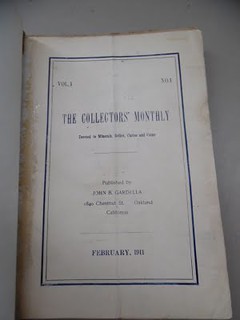 In February 1911, he and his wife began to publish Collectors' Monthly, devoted to general collecting with articles and news about coins, stamps, relics, curios, minerals and so
on in each issue. Advertisers included coin dealers : W. F. Greany of San Francisco, Charles K. Warner of Philadelphia, Arthur H. Kraus of Milwaukee, R. L. Dietrick of Lorraine, Virginia, Frank Dodge
of Mechanicsburg, Pennsylvania, Robert Blakely of Prescott, Arkansas, Lewis Brodstone of Superior, Nebraska, Ben Cohen of Oakland, John P. Pittman of Plymouth, Illinois, and of Winnebgo, Minnesota,
P. C. Hartell of Whitestone Landing, New York, H. Landecker & Co., of San Francisco, Fred Michael of Chicago, T. J. Baldwin of New York, Arthur Grote, Woodstock, Illinois, S. Archie Hamilton, of
Cresco, Iowa, and so on. Numismatic articles included a survey of prices for Large Cents, the 1853 Half Dollar, and a column by P. C. Hartell discussing coin auction sales in New York each month.
In February 1911, he and his wife began to publish Collectors' Monthly, devoted to general collecting with articles and news about coins, stamps, relics, curios, minerals and so
on in each issue. Advertisers included coin dealers : W. F. Greany of San Francisco, Charles K. Warner of Philadelphia, Arthur H. Kraus of Milwaukee, R. L. Dietrick of Lorraine, Virginia, Frank Dodge
of Mechanicsburg, Pennsylvania, Robert Blakely of Prescott, Arkansas, Lewis Brodstone of Superior, Nebraska, Ben Cohen of Oakland, John P. Pittman of Plymouth, Illinois, and of Winnebgo, Minnesota,
P. C. Hartell of Whitestone Landing, New York, H. Landecker & Co., of San Francisco, Fred Michael of Chicago, T. J. Baldwin of New York, Arthur Grote, Woodstock, Illinois, S. Archie Hamilton, of
Cresco, Iowa, and so on. Numismatic articles included a survey of prices for Large Cents, the 1853 Half Dollar, and a column by P. C. Hartell discussing coin auction sales in New York each month.
In May 1916, he published his final issue of Collectors' Monthly.
In 1920, he lived in Diamond Springs, El Dorado County, California where he worked a gold mine as a prospector.
In 1930, he owned an orchard at Placerville, El Dorado County, California. He remained there the rest of his life.
He published four articles in the Placerville Times on the old gold miners of El Dorado County. He intended to publish a book on that subject but he died prior to undertaking that task.
He died on Saturday, August 25, 1961, at his orchard in the Camino area, El Dorado County, California. He was cremated at East Lawn, Sacramento, California.
To read the complete article, see:
GARDELLA, JOHN BAPTIST
(https://sites.google.com/a/numismaticmall.com/www/numismaticmall-com/gardella-john-baptist)
The entire inventory of the Lupia Numismatic Library is for sale. Since neither the Chapman Family Correspondence Archive as a whole nor that of Hiram Edmond Deats could find an institutional or private buyer they shall, unfortunately, be broken up into parcels and sold from the NumismaticMall.com.
Every item in the Deats and Chapman Archives will be sold to anyone bidding a fair market price. Individual items will be available before the remaining archives are broken up into parcels sold at philatelic auctions in the U. S. and Hong Kong.
Check NumismaticMall.com frequently as dozens of new items with estimates will be posted daily beginning August 21, 2017 until everything is sold lock stock and barrel. Many treasures and surprises will be found, so keep looking.
All inquiries will be given prompt and courteous attention. Write to: john@numismaticmall.com .
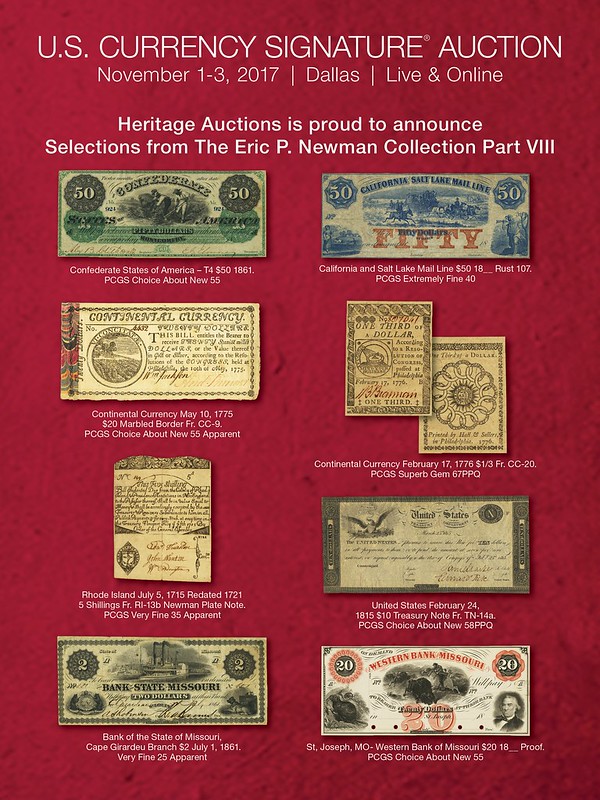
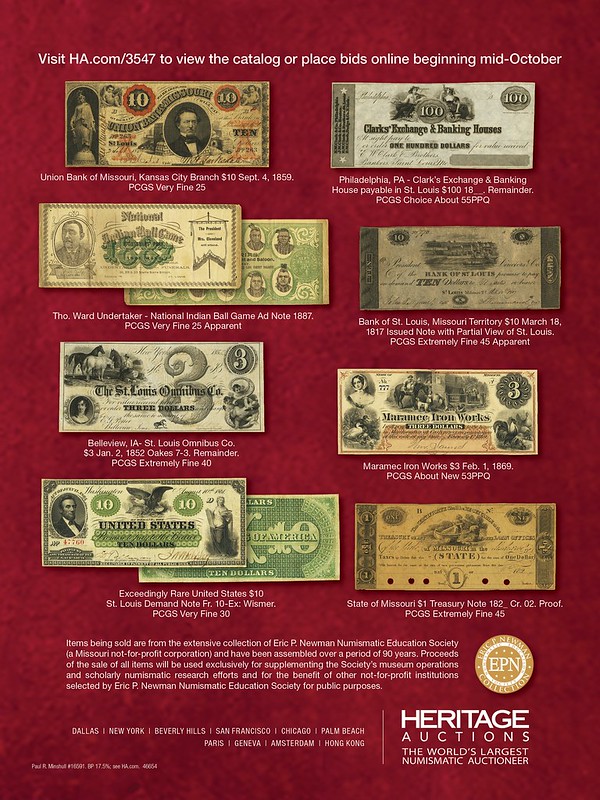
MNUCHIN MAY RECONSIDER HARRIET TUBMAN $20 BILL

Wait a minute on that plan to put Harriet Tubman on the $20 bill.
The Trump administration is reconsidering an Obama-era initiative to make U.S. Mint history by replacing Andrew Jackson with the 19th-century American abolitionist as the face of the $20 bill, Treasury Secretary Steven Mnuchin told CNBC on Thursday.
"Ultimately we will be looking at this issue," he said. "It's not something I'm focused on at the moment."
His comment triggered instant ire on social media from the plan's supporters...
After nearly a year of debate, former Treasury secretary Jack Lew announced in April last year that Tubman will be placed on the front of the $20 bill while Jackson gets reassigned to the rear.
The decision was part of the department's broader efforts to redesign the $10, $20 and $5 bills and place female historical figures on the notes.
The new $20 bill and other redesigned notes were scheduled to be issued in 2020 to mark the 100th anniversary of the 19th Amendment, which granted women the right to vote.
To read the complete article, see:
Treasury Secretary Steve Mnuchin just put Harriet
Tubman's role on $20 bill in question (https://www.usatoday.com/story/money/2017/08/31/treasury-secretary-steve-mnuchin-just-put-harriet-tubmans-role-20-bill-question/621103001/)
In April 2016, then-Treasury Secretary Jacob J. Lew announced that Jackson would move to the back of the $20 bill. He also said that images of women would be added to the back of the $5 and $10 bills.
Mr. Lew said final designs would be unveiled in 2020, with production starting later in the decade. The government regularly redesigns paper currency to frustrate counterfeiters, but the people honored on the bills have remained the same for nearly a century. Other nations, notably Britain, regularly rotate honorees, though Queen Elizabeth II remains on all the bills.
Mr. Lew was aware when he made the decision to redesign the currency that its fate would rest with Mr. Obama’s successor. But he said then that he doubted it would be reversed.
“I don’t think somebody’s going to probably want to do that — to take the image of Harriet Tubman off of our money? To take the image of the suffragists off?” he said.
Treasury had earlier removed its “Modern Money” website that the Obama administration created to highlight its plans for the redesigned bills.
Harriet Tubman was born enslaved, escaped to freedom and then returned repeatedly to the part of Maryland where she grew up to lead other slaves to freedom. She served as a Union scout during the Civil War and later become a prominent advocate for giving women the right to vote.
To read the complete article, see:
Mnuchin Doesn’t Endorse Placing Harriet Tubman on the New $20 Bill
(https://www.nytimes.com/2017/08/31/us/politics/mnuchin-harriet-tubman-jackson-money.html)
The decision was seen as a watershed moment in American history. “The fact that women’s history is being included and honored on American banknotes is a huge shift, a huge moment,” Ellen Feingold, curator of the National Numismatic Collection at the Smithsonian’s National Museum of American History, told Newsweek at the time. Real-life women last appeared on banknotes a century ago, and no African-American ever appeared on U.S. federal currency. (Confederate states did portray African-Americans, but only as slaves.)
Trump, who has shown admiration for Jackson by hanging his portrait in the Oval Office, did not agree with the move, which he dubbed “pure political correctness.”
To read the complete article, see:
THE TRUMP ADMINISTRATION WANTS ONLY DEAD WHITE MEN ON U.S. BANKNOTES, BUT
AMERICANS DISAGREE (http://www.newsweek.com/trump-administration-wants-only-dead-white-men-us-banknotes-americans-disagree-658414)
To read the earlier E-Sylum article, see:
CHANGES TO U.S. PAPER MONEY PORTRAITURE (http://www.coinbooks.org/esylum_v19n17a18.html)
VIDEO: RESOLUTE AMERICANA CONTINENTAL DOLLARS

Collector Robert Rodriguez approaches coin collecting with enthusiasm, a keen eye for quality, and a deep appreciation for numismatic history and research.
In this remarkable CoinWeek IQ video, Rodriguez sits down with NGC Chairman Mark Salzberg at the American Numismatic Association's (ANA) 2017 World's Fair of Money to discuss The Resolute Americana Collection of 1776 Continental Dollars - the most complete collection of the type ever assembled.
In assembling the collection, Rob has gained new insights and appreciation for the series that has long puzzled numismatic researchers and scholars. He shares this insights with Mark and with you.
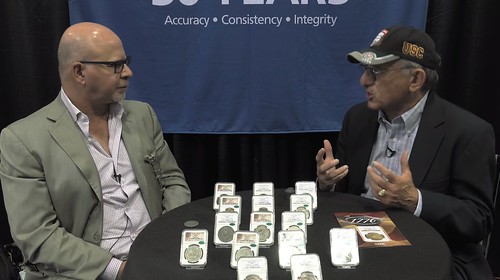
To watch the complete video, see:
CoinWeek IQ: Resolute Americana Collection of Continental Dollars – 4K Video
(http://www.coinweek.com/video-news/resolute-americana-collection-of-continental-dollars/)

COUNTERFEIT 1787 MASSACHUSETTS “4C” HALF CENT
A comment I have heard in regards to these latest struck fakes is that the counterfeiters do not copy low grade or common coins; the subject of this latest article begs to differ and I titled my initial C4 (Colonial Coin Collectors Club) News Letter article “A Story of a Curious “4-C Massachusetts 1/2 Cent”. This is intended as an installment disclosing discovered current deceptive struck counterfeits and establishing attribution guides for each; this article was revised from a previously posted version in Coin Week. The research continues to be a collaborative effort with many participating numismatic club, Face Book “Dark Side” members and friends participating.
Note: "Dark Side" is our counterfeit-focused Facebook page, spun out of Early American Copper’s Copper Notes to include non-members of EAC with an interest in participating in a forum on this subject.
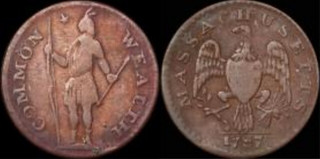
After seeing this “coin” listed for auction on the internet by one of the apparently connected sellers I monitor I immediately turned my “suspicious eye” on it; starting with the third-party grading (TPG) certification I became even more suspicious of this one, as the on-line cert verification stated “Grade: CONTACT CUSTOMER SERVICE”. I pulled the pics from the listing and emailed them to several C4/EAC folks I know for their opinions, as this was my first look at a Massachusetts copper. The results drove more questions, as the pics weren’t great and the “coin” wasn’t in-hand but everyone who reviewed it stated concerns about its possible authenticity; another consideration was the possibility it was an unknown die state/ variety, so how cool would that be?
Biting the bullet, I decided to “win” the auction (for an undisclosed embarrassing price) and turn this research article into another personal learning experience thanks to the help of several “copper friends”.
One of the initial steps I take in investigating an interesting “coin” is to compare it to images of a known genuine example. There are many outstanding coin related web sites to use as resources to this end (auction houses, TPG sites, etc.). In this case I found a similar example of the same variety on Heritage’s web site and created the comparison images as follows:
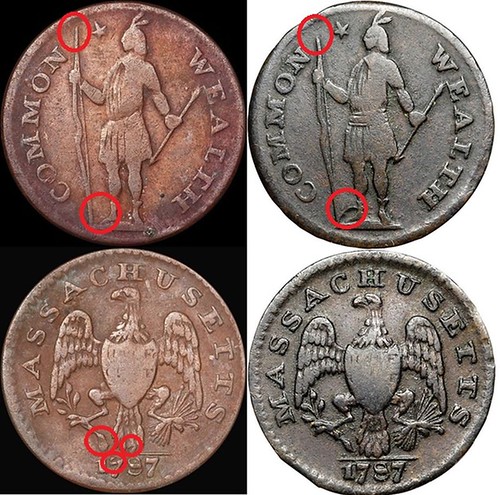
The red circles highlight areas of differences between these two examples. From this review it became more apparent how to search for other ones, concentrating on the differences to a known one AND the apparent damage noted at the lower eagle/ date area of the suspect one.
Since last fall we have found two more examples of this one; the 1st in December 2016 was encapsulated by one of the TPG’s, the 2nd example was listed on the internet in June 2017 and was raw. That makes the current count seven documented examples with no way to know how many more are actually “out there”!
Continued research and internet searches did produce additional examples with identical “circulation/ damage marks” (known to our group as “sister marks”) as well as the differences noted from a known genuine example. It is appropriate to note we have seen other examples of documented struck counterfeit early coppers with a die break like the one from the foot to the bow always seen on this variety tooled away in the fakes (ref our article on the 1798 “S-158’s”)
For more information on the Colonial Coin Collectors Club, see:
http://colonialcoins.org/
For more infornation on Early American Coppers club, see:
http://eacs.org/
THE BOOK BAZARRE
REBEL WON FRACTIONAL NOTE FROM GENERAL SCOTT

When we are presented with a fractional items that has a contextual reference it gives us a moment to pause. No longer is it just a piece of fractional, it becomes something much more. In this case it becomes human and relatable. From FCCB’er Ronn Palm is a fascinating artifact from the Post Civil War era.
In 1866, the war is mercifully over but sentiments between the South and North were still painful and quite raw. With memory of 620,000 dead and a recently assassinated President still burning in the souls of Americans, even a low stakes card game of Whist (a game that is the pre-cursor to bridge) becomes so much more. The game took place at The St. Charles Hotel in New York State between an unknown Rebel and a famous Union General. No doubt emotions were still running very high. On the reverse of an ordinary Justice fractional (FR1363) is a very telling hand written inscription.
Whist Winner:
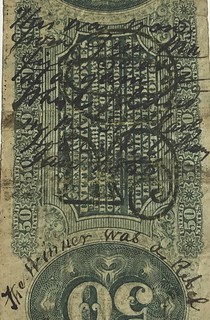 The winner is an unnamed Rebel. His name was lost over the annals of times. Most likely if he was engaged in a quasi-friendly gambling game with a famous Union General, he must have been a
man of some achievement. It is apparent that over the “50 Oval” on the left side he was proud of his achievement. Simply stated: ‘THE WINNER WAS A REBEL’…it speaks volumes. The 50¢ won is a trivial
sum, but the fact he won the game over a distinguished Union General was a source of great pride. The message was clear: “The South lost the war, but darn it, I beat the General in a card game and
achieved a small measure of revenge.” Not content to just stick in his pocket, the Rebel had to memorialize the victory on the note and declare himself on who he was…’A Rebel’. Too bad he didn’t sign
his name, but it’s obvious he was proud of his heritage.
The winner is an unnamed Rebel. His name was lost over the annals of times. Most likely if he was engaged in a quasi-friendly gambling game with a famous Union General, he must have been a
man of some achievement. It is apparent that over the “50 Oval” on the left side he was proud of his achievement. Simply stated: ‘THE WINNER WAS A REBEL’…it speaks volumes. The 50¢ won is a trivial
sum, but the fact he won the game over a distinguished Union General was a source of great pride. The message was clear: “The South lost the war, but darn it, I beat the General in a card game and
achieved a small measure of revenge.” Not content to just stick in his pocket, the Rebel had to memorialize the victory on the note and declare himself on who he was…’A Rebel’. Too bad he didn’t sign
his name, but it’s obvious he was proud of his heritage.
For more information on the Society of Paper Money Collectors, see:
https://www.spmc.org/

NUMISMATIC NUGGETS: SEPTEMBER 3, 2017
Silver Tetradrachm
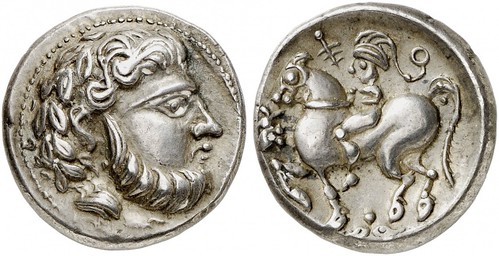
Õ-Tetradrachme, Typ Baumreiter mit Bartkranzavers, 2./1. Jahrhundert v. Chr.; 14.16 g. Kopf r. mit Lorbeerkranz//Reiter l. mit "Baum", davor Vierbeiner, unten Blattornament. Dembski 1085 a; Kostial 416; Göbl, Ostkelten 129; Slg. Flesche 691.
To read the complete lot description, see:
Õ-Tetradrachme, Typ Baumreiter mit Bartkranzavers, 2./1. Jahrhunde (https://www.kuenker.de/en/auktionen/stueck/165783)
1787 Ordinance for the Establishment of the Mint of the United States
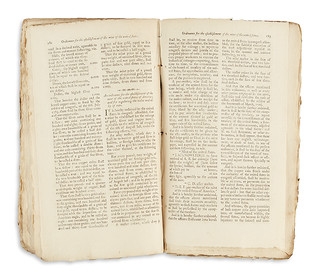 (FINANCE.) Issue of the [America]n Museum featuring the United States Mint ordinance. [105]-207, [1] pages. 8vo, disbound; printing error has caused the title to print incompletely, minor
foxing and wear; uncut. Philadelphia: Mathew Carey, August 1787 Estimate $500 - 750 This issue features early printings of the Northwest Ordinance (pages 188-192), "An Ordinance for the
Establishment of the Mint of the United States" (pages 182-184), and more.
(FINANCE.) Issue of the [America]n Museum featuring the United States Mint ordinance. [105]-207, [1] pages. 8vo, disbound; printing error has caused the title to print incompletely, minor
foxing and wear; uncut. Philadelphia: Mathew Carey, August 1787 Estimate $500 - 750 This issue features early printings of the Northwest Ordinance (pages 188-192), "An Ordinance for the
Establishment of the Mint of the United States" (pages 182-184), and more.
To read the complete lot description, see:
Issue of the [America]n Museum featuring the United States Mint
ordinance. (https://www.barnebys.com/auctions/lot/449664959/issue-of-the-american-museum-featuring-the-united-states-mint-ordinance/)
1970 Salvador Dali King David Medal

SALVADOR DALÍ
King David.
Bronze medal from an original wax mould, 1970. 115 mm; 4 1/2 inches (diameter). Signed in the casting and incised with the numbering 276/400. Cast at the Hôtel des Monnaies de Paris. From the portfolio Our Historical Heritage
To read the complete lot description, see:
SALVADOR DALÍ King David.
(http://catalogue.swanngalleries.com/asp/fullCatalogue.asp?salelot=2454+++++543+&refno=++737114&saletype=%20)
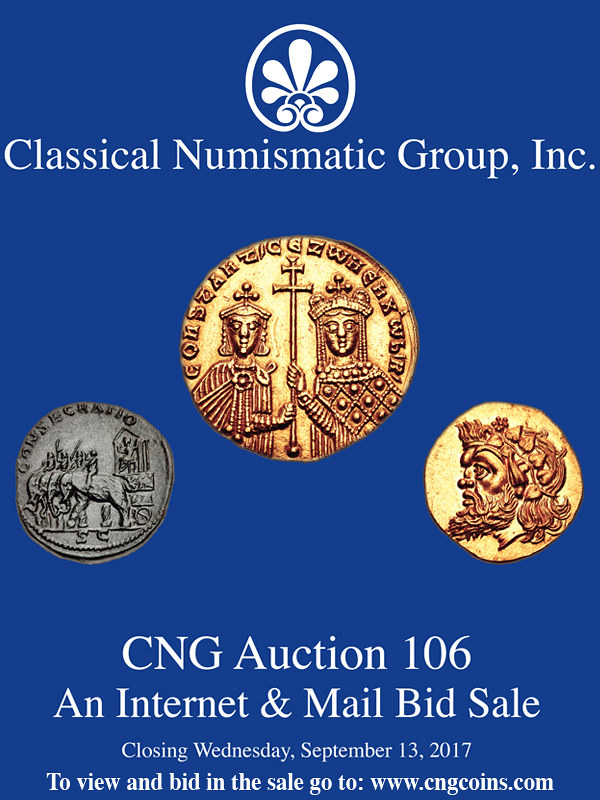
PAN AUCTION CLOSES OCTOBER 27, 2017
1910 Pennsylvania Monument at Gettysburg Medal

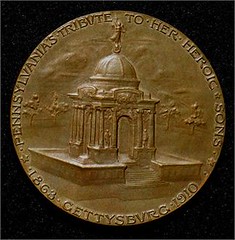
Bronze medal 2.5" in diameter by Davidson of Philadelphia (marked on edge). Obverse of medal features image of Pennsylvania monument at Gettysburg with text "Pennsylvania's Tribute to her Heroic Sons 1863 Gettysburg 1910". Reverse of medal features a portrait of General Meade. Provenance: The Meade Family Collection.
To read the complete lot descriptions, see:
Pennsylvania monument at Gettysburg dedication medal, 1910
(http://www.go2coinauctions.com/Listing/Details/3411463/Pennsylvania-monument-at-Gettysburg-dedication-medal-1910)
Medal for Dedication of Pennsylvania Monument at Gettysburg.
(http://www.icollector.com/Medal-for-Dedication-of-Pennsylvania-Monument-at-Gettysburg_i613056)
2004 Carnegie Hero Fund 100th anniversary medal
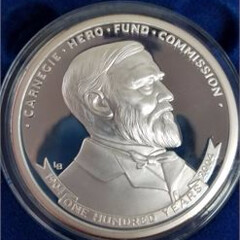
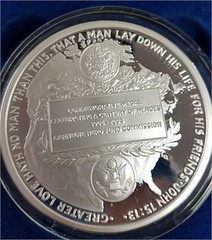
To read the complete lot description, see:
2004 Carnegie Hero Fund 100th anniversary medal
(http://www.go2coinauctions.com/Listing/Details/3411781/2004-Carnegie-Hero-Fund-100th-anniversary-medal)
1715 Fleet 8 Reales Silver Cob
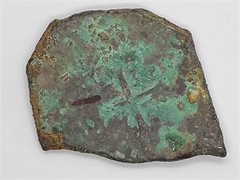
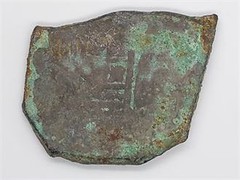
To read the complete lot description, see:
1715 Fleet Shipwreck Recovery 8 Reales Silver Cob 26.0g
(http://www.go2coinauctions.com/Listing/Details/3505494/1715-Fleet-Shipwreck-Recovery-8-Reales-Silver-Cob-260g)
1945 Motion Picture Industry Plaque
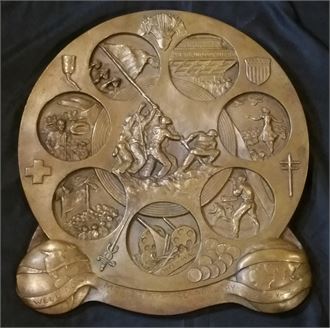
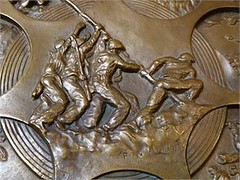
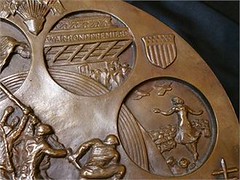

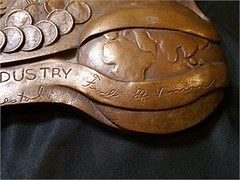
An impressive Bronze Plaque by Felix de Weldon, measures 15 1/2" x 14 1/2" and shaped like a motion picture reel.
To read the complete lot description, see:
1945 WWII Bronze Plaque by Felix de Weldon "Well
Done Motion Picture Industry" (http://www.go2coinauctions.com/Listing/Details/3513337/1945-WWII-Bronze-Plaque-by-Felix-de-Weldon-Well-Done-Motion-Picture-Industry)

THE FRENT POLITICAL MEMORABILIA COLLECTION
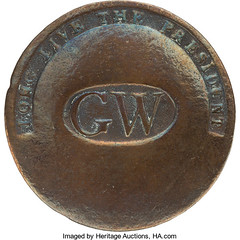 The landmark political memorabilia collection of David and Janice Frent - widely regarded as the largest and most comprehensive collection of its kind ever assembled - will debut October 21
at Heritage Auctions with Auction #6181, the first of at least eight auctions dedicated to the collection. The items included span everything from buttons to banners, from George Washington up
through recent elections. The collection has never been displayed publicly, but a number of items can be seen illustrating the important two-volume reference work Running for President, The
Candidates and Their Images, edited by eminent historian Arthur M. Schlesinger, Jr. and published by Simon & Schuster in 1994.
The landmark political memorabilia collection of David and Janice Frent - widely regarded as the largest and most comprehensive collection of its kind ever assembled - will debut October 21
at Heritage Auctions with Auction #6181, the first of at least eight auctions dedicated to the collection. The items included span everything from buttons to banners, from George Washington up
through recent elections. The collection has never been displayed publicly, but a number of items can be seen illustrating the important two-volume reference work Running for President, The
Candidates and Their Images, edited by eminent historian Arthur M. Schlesinger, Jr. and published by Simon & Schuster in 1994.
"Presenting this monumental collection at auction will be quite a challenge," Tom Slater said. "I have presided over the auction sale of some of the greatest political collections, including those of U.I. 'Chick' Harris and Merrill Berman. But the Frent Collection dwarfs even those legendary holdings. We anticipate a minimum of eight quarterly catalog auctions of 500-600 lots each, and those will include just the more important pieces in the collection. The Harris and Berman collections each realized over $2 million dollars at auction, and the Frent Collection will unquestionably achieve multiples of that amount."
The collection was begun by the Frents when they were newlyweds nearly a half century ago, when they happened on a Mason jar containing some colorful turn-of-the-century political buttons including "Rough Rider" Theodore Roosevelt. Both already had an affinity for American history, and these tangible artifacts immediately caught their fancy. Little did they know that the chance discovery would ultimately result in a collection which would occupy eight rooms in the Frents' spacious suburban home. "It's hard to imagine living without the collection," Janice said, "but over time the burden of being its custodians has grown harder to bear; it's a great responsibility. Now we find ourselves looking forward to sharing these much-loved treasures with a new generation of collectors." The collection is now securely ensconced at our Dallas headquarters, where it will be inventoried and cataloged for auction.
While the profusion of rare and unusual objects is astonishing, the uniformly high condition standards maintained by the collectors is also remarkable.
"Over the years, prices of rare political items have risen to the point where many purchases amount to investment decisions," Slater said. "When that occurs in a collecting field, condition becomes more and more important. Clearly this was a priority from day one for the Frents. That practice should pay real dividends for the sellers as we auction the collection. Many of the pieces are the finest we have ever seen, and that will not go unnoticed by bidders."
"We always tried to obtain the finest condition available," David said, "and if we had the opportunity to upgrade, we always took it. We weren't thinking in investment terms in those days. We just wanted the most appealing examples we could find."
To view the Frent auction lots, see:
https://historical.ha.com/c/search-results.zx?N=49+792+4294949631&type=collectord-1--hist--news--tem083017

SALEM CYPRUS BANKNOTES AT HERITAGE
Heritage Auctions Presents Finest Offering Ever of Cypriot Currency
Ibrahim Salem Collection of Cyprus set for Auction Sept. 8 in Long Beach, California
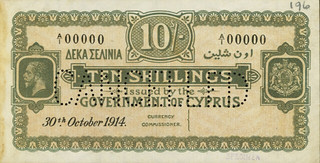 Before the 20th century, most of Cyprus’ money needs were filled by coins from the British Empire, Turkey and other countries in the area. By 1914, World War I was contracting coin
supplies, and an emergency paper issue was released in Cyprus. That was the start of Cyprus issuing its own paper money.
Before the 20th century, most of Cyprus’ money needs were filled by coins from the British Empire, Turkey and other countries in the area. By 1914, World War I was contracting coin
supplies, and an emergency paper issue was released in Cyprus. That was the start of Cyprus issuing its own paper money.
The Ibrahim Salem Collection of Cyprus is the finest offering of currency from this strategically important island nation to go to auction. The vast political changes in the last century have produced a wide array of notes, with stunning designs of monarchy and antiquity.
Salem is a banknote collector of over 40 years. His passion for artistry and history led him into architecture and collecting. He is one of the most prolific architects in Dubai, with hardly a spot in the skyline that does not feature one of his projects.
Notes Issued Under British Authority
The notes issued under the British Authority include a number of highlights in this collection. Three Specimen issues of the 1914 Emergency Issue are included, each one expected to bring more than
$20,000. The collection features many of the dates and denominations issued under King George V, all of which are incredibly scarce, including a rarely seen and fully issued 1936 £5 in PMG Very Fine
30.
Notes of King George the VI are rare in these grades, and rarely accompanied by so many Specimen issues. One of the most desirable is the 10 Shilling Specimen from the 1952-53 Issue.
Queen Elizabeth’s coronation in 1953 was preceded by a tremendous amount of pomp and planning. One of the die trials of her official currency portrait that was submitted for approval is expected to bring $1,000-2,000. The last dated £5 note issued before the Republic under Queen Elizabeth is one of just a few examples known and is expected to realize more than $15,000.
Notes of the Republic
Salem’s holdings from the Republic of Cyprus are unequaled. In addition to achieving some of the finest grades known for Cyprus, a large number of the issues from the 1960s into the 1990s are serial
number 1 issues, including the first 250 Mils and 500 Mils notes printed and released.
Artistry and Design
Beginning with the first issues of Cyprus, Salem sought design and color trials, specimens and proofs that represent interesting views of the design process. The trials from 1917-20 are extremely
scarce, with each expected to command $7,000 or more. An unissued design trial featuring Makarios III, the founder of modern Cyprus, never was issued. It is expected to bring more than $4,000.
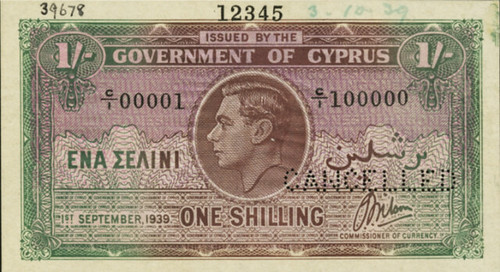
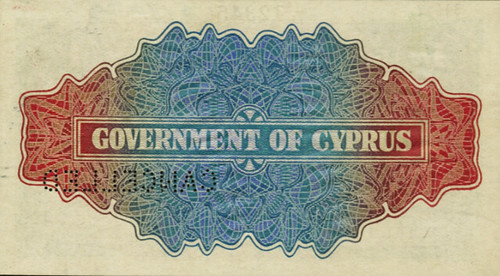
To view the lot listings, see:
The Ibrahim Salem
Collection of Cyprus (https://www.ha.com/c/search-results.zx?Nty=1&Ntk=SI_Titles
-Desc&Ns=Price%7c1&N=0+793+794+791+792+1893+1577+2088&Ntt=
%22Ibrahim+Salem+Collection%22&ic4=SortBy-071515)
HAWAII LAHAINALUNA SEMINARY NOTES OFFERED
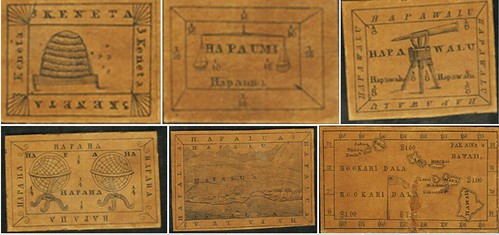
Rare Hawaii Lahainaluna Seminary Notes
(Kingdom of Hawaii)- Lahainaluna Seminary 3 Keneta; Hapaumi $1/16; Hapawalu $1/8; Hapaha $1/4; Hapalua $1/2; Hookahi Dala $1 ND (circa 1843) PCGS Graded
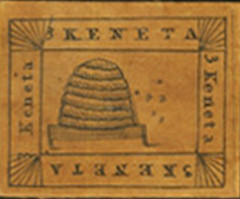 These are very rare and historical notes. Protestant missionaries came to Hawaii in 1823 and discovered that there was no written form of the Hawaiian language. They formed a committee that
created the written form that is still in use today and also convinced the Hawaiian royalty of the need for an educational system. The missionaries next established the Lahainaluna Seminary in 1831,
which is still in existence today as the Lahainaluna High School. It is the oldest public school west of the Rocky Mountains.
These are very rare and historical notes. Protestant missionaries came to Hawaii in 1823 and discovered that there was no written form of the Hawaiian language. They formed a committee that
created the written form that is still in use today and also convinced the Hawaiian royalty of the need for an educational system. The missionaries next established the Lahainaluna Seminary in 1831,
which is still in existence today as the Lahainaluna High School. It is the oldest public school west of the Rocky Mountains.
 In 1834, the Hale Pa'i or House of Printing was founded on campus and it was the home of Hawaii's first printing press. Students were able to study intaglio engraving on copper
plates under the tutelage of Reverend Lorrin Andrews. They produced many pictorial items that were needed in quantity. In fact, the first newspaper printed west of the Rocky Mountains was printed at
the school. The quaint pieces in this lot possibly originated on Hawaii's first printing press.
In 1834, the Hale Pa'i or House of Printing was founded on campus and it was the home of Hawaii's first printing press. Students were able to study intaglio engraving on copper
plates under the tutelage of Reverend Lorrin Andrews. They produced many pictorial items that were needed in quantity. In fact, the first newspaper printed west of the Rocky Mountains was printed at
the school. The quaint pieces in this lot possibly originated on Hawaii's first printing press.
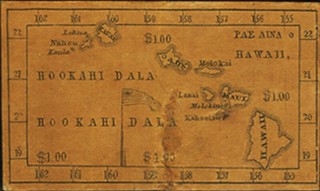 The notes portray school subjects and virtues such as industry, law, science, geography, education, and a map of the Hawaiian Islands, plus the national flag on the highest denomination.
They are all of the altered plate secret marks variety and each note was also backed at issue. The 3 Keneta and Hapaumi grade Very Choice New 64. The Hapawalu, Hapaha, and Hapalua all grade Choice
New 63. The Hookahi Dala grades Apparent New 60 with damage on the face, which interferes very little with the overall printing. We auctioned a similar PMG graded set in January 2009 for $25,300 and
would not be surprised if that figure was easily eclipsed tonight.
The notes portray school subjects and virtues such as industry, law, science, geography, education, and a map of the Hawaiian Islands, plus the national flag on the highest denomination.
They are all of the altered plate secret marks variety and each note was also backed at issue. The 3 Keneta and Hapaumi grade Very Choice New 64. The Hapawalu, Hapaha, and Hapalua all grade Choice
New 63. The Hookahi Dala grades Apparent New 60 with damage on the face, which interferes very little with the overall printing. We auctioned a similar PMG graded set in January 2009 for $25,300 and
would not be surprised if that figure was easily eclipsed tonight.
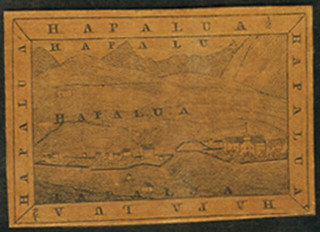
To read the complete lot description, see:
(Kingdom of Hawaii)- Lahainaluna Seminary 3 Keneta; Hapaumi $1/16; Hapawalu $1/8; Hapaha $1/4; Hapalua $1/2; Hookahi ...
(https://currency.ha.com/itm/obsolete-banknotes/-kingdom-of-hawaii-lahainaluna-seminary-3-keneta-hapaumi-1-16-hapawalu-1-8-hapaha-1-4-hapalua-1-2-hookahi-dala-1-total-6-notes-/a/3557-20136.s?ic4=GalleryView-Thumbnail-071515#)
To read the complete Coin World article, see:
Six notes from Lahainaluna Seminary in Hawaii in Heritage auction
(http://www.coinworld.com/news/paper-money/2017/08/hawaiian-seminary-notes-first-for-the-islands-kindgom.html)

'RARE' 5-MILLION DEUTSCHMARK COIN FOUND

The coin dates back to 1923. The inscription on the coin offers an insight into the economic crisis that plagued Germany after the First World War.
Police in the northwestern German city of Cologne hit an unexpected jackpot when they chanced upon historical coins and currency notes during a drug-related search.
The historical loot was found in a black carry-on suitcase in May 2017, police said on Thursday.
Among them was a 5-million deutschmark coin from 1923, when Germany was in the midst of an economic crisis. Hyperinflation ran rampant at the time, resulting in constantly devalued money. 4.2 trillion marks were worth just $1.
The inscription on the coin reads: "Emergency money from Westphalia Province, 1923," referring to the German state.
World War-era square banknotes from France and the Netherlands were also among the currency notes discovered.
To read the complete article, see:
German police find rare 5-million deutschmark coin during drug search
(http://www.dw.com/en/german-police-find-rare-5-million-deutschmark-coin-during-drug-search/a-40319226)
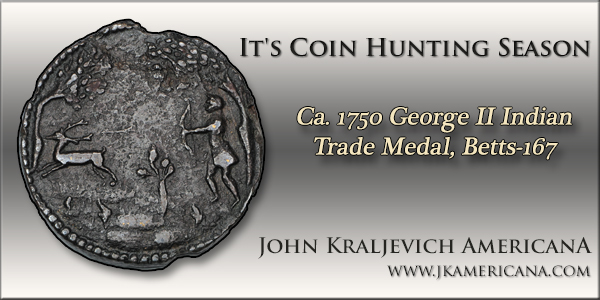
SIGNEVIERISTS: FIRE MARK COLLECTORS
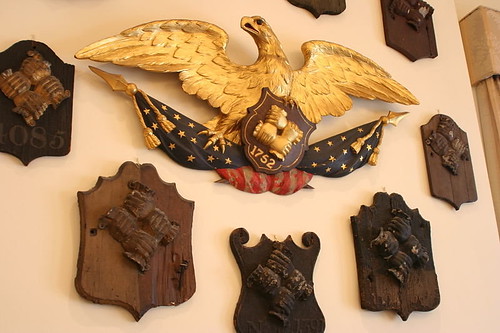
DECORATIVE CRESTS BEARING EAGLES, CLASPED hands, and shining suns were once signs of membership in a special club. They showed that the building to which they were affixed was insured against fire—and that if the building caught on fire, a private fire brigade would come to attempt to put it out. Now, long after their heyday, these plaques, known as “fire marks,” have become collector’s items—every bit as fascinating and artful today as they were when they were installed.
After the Great Fire of London in September 1666, which damaged or destroyed huge swaths of the historic city, the need for a more organized response to fires became tragically apparent. This led to the creation of the world’s first property insurance policies, issued by what is considered the world’s first insurance company, called the “Fire Office.” Despite its official-sounding name, the Fire Office was not a municipal department, but a private company. At the beginning, it provided money for the restoration or reconstruction of buildings damaged by fire.
Not long after the Fire Office was established, a number of other insurance outfits began to appear. According to the Museum of London, one of every 10 houses in London was insured by 1690. As time passed, many insurance companies wised up to the fact that it was cheaper to prevent and fight fires than simply to pay the cost of reconstruction, and that’s where fire marks come in. Insurance companies such as the Fire Office established their own in-house fire brigades, tasked with protecting the buildings covered under policy—and, in many cases, only those buildings. If another company’s brigade put out a fire in a building insured by a different company, they might be reimbursed for their trouble, but if your building did not carry a crest, it might be left to burn. To designate which buildings were covered by which company’s brigade, fire marks were installed on the exteriors of the buildings.
By the time that the idea of fire insurance made its way to the Untied States, volunteer fire brigades were already a well-established tradition to protect the common good. Fire marks, which first took hold in Philadelphia, where some can still be found today, functioned simply as insurance advertisements, and as a sort of turf mark.
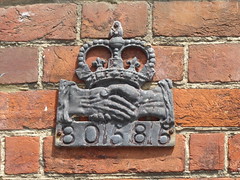
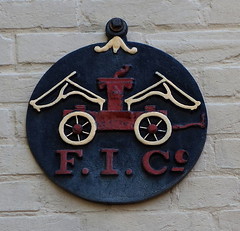
The most iconic of Philadelphia’s fire marks was that of the Ben Franklin–founded Philadelphia Contributionship, which bore the image of four hands grabbing each other by the wrists. It was often molded out of metal and affixed to a wooden shield.
Today, fire marks survive as historic points of interest or collector’s items. Like philatelists and numismatists (collectors of stamps and coins, respectively), people who study and collect fire marks have a name: signevierists. Probably the most organized group of signevierists is the Fire Mark Circle of America, which oversees a number of auctions and connects enthusiasts. Their auction listings even act as a sort of database of the wide variety of preserved marks being traded around.
To read the complete article, see:
A Short History of Fire Marks, The World’s Hottest Insurance-Related Antiques
(http://www.atlasobscura.com/articles/fire-mark-collectible-insurance-crest)

THE THIRD DEGREE KNICKER PIE EATER’S CLUB
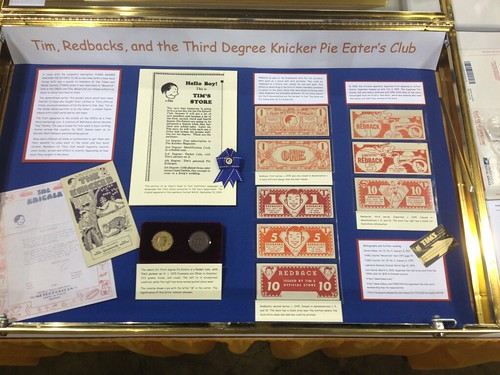
A token with the enigmatic inscription THIRD DEGREE KNICKER PIE EATER’S CLUB on two lines (with a male head facing left) was a puzzle to members of the Token and Medal Society (TAMS) when it was described in “Maverick” lists in the 1960’s and 70’s. Mavericks are tokens without an issuer or place inscribed on them.
Two generations earlier this pocket piece would have been familiar to boys who bought their clothes at Tim’s Official Store, as proud members of his Pie Eater’s Club.
See, Tim is the fellow whose portrait is on the token – a simple figure, always with a half-smile and no last name. Tim first appeared in the middle of the 1920’s as a free lance marketing icon. A creation of Baltimore native Herman “Kay” Kamen, Tim was a brand for hire used in boys clothing stores across the country. In 1933, Kamen went on to become Walt Disney’s merchandising genius.
Boys were offered all kinds of promotions to get them and their parents to come back to the store and buy more clothes. Members of Tim’s Club would regularly receive comic books, prizes and offers to events, depending on how much they bought in the store.
Redbacks (a play on the “Greenbacks” term for US currency) were given as a bonus with each purchase. They could be redeemed at a future visit, usually for one cent each. This effective advertising in the form of “money” reminded customers to return to the store. Since they were saved as having some value, Redbacks are available ephemera. All are fairly scarce, but the 5 denominations are the hardest to find.
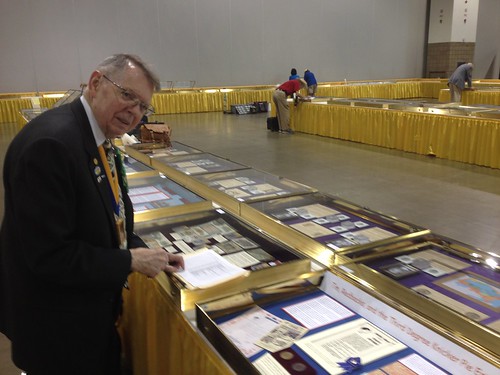
Joe Boling reviewing the exhibit
Bibliography and further reading:
Calcoin News, Vol. 21, No. 4, January 9, 1967
TAMS Journal “Mavericks” April 1971 page 79
TAMS Journal> Vol. 15, No. 3, January 6, 1975
Lawrence [Kansas] Journal-World Sep 10, 1926
https://news.google.com/newspapers?nid=2199&dat=19260910&id=-AZGAAAAIBAJ&sjid=5ucMAAAAIBAJ&pg=4227
Coin World, March 6, 2015. Superman fan club scrip note from the 1940s sells for $28 in Internet auction
http://www.coinworld.com/news/paper-money/2015/03/Superman-Tim-scrip-note-from-the-1940s-sells-for-28-in-auction.html#
https://www.hakes.com/Auction/ItemDetail/87805/SUPERMAN-TIM-MINI-PENNANT-LETTER
http://www.fanboy.com/2009/04/the-superman-tim-club-card-membership-has-its-rewards.html
http://scoop.previewsworld.com/Home/4/1/73/1016?articleID=45795
COMMEMORATIVE COINS FOR WARTIME SEX SLAVES?
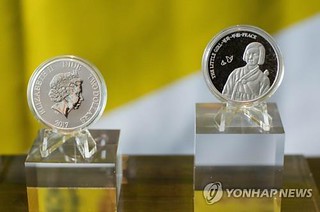 Kim Seo-kyung and her husband Kim Eun-sung, who designed the statue of a girl symbolizing the victims of Japan's wartime sexual slavery which sits near the Seoul-based Japanese Embassy,
recently launched another project to call on Tokyo to repent of its wrongdoings by issuing a commemorative coin.
Kim Seo-kyung and her husband Kim Eun-sung, who designed the statue of a girl symbolizing the victims of Japan's wartime sexual slavery which sits near the Seoul-based Japanese Embassy,
recently launched another project to call on Tokyo to repent of its wrongdoings by issuing a commemorative coin.
The statue was first erected in 2011 to mark the 1000th weekly protest staged by the victims of Japan's sexual enslavement during the colonial period (1910-45), euphemistically called comfort women. Since, then there have been various efforts to erect similar statues at home and abroad, with the aim of compelling Tokyo to admit to its past crimes and deliver an official apology.
With the girl statue becoming a rallying point for the victims, the Kims decided to expand their project to a different level by commissioning a coin inscribed with the statue, and bringing it to the attention of coin collectors
The Kims, however, believed it was unlikely that South Korea will officially decide to issue a coin considering the sensitivity of the issue. Under the ousted President Park Geun-hye, Seoul and Tokyo agreed to settle the long-standing issue with compensation of 1 billion yen (US$9 million), which will spent on building a foundation.
"We first considered issuing a collectible medal, but later decided to expand the project to make it more symbolic," Kim Eun-sung added. "Many activists, including teenagers, are voluntarily making badges or other souvenirs to help the surviving victims. This is where we got the inspiration for the coins."
To read the complete article, see:
(Yonhap Feature) Commemorative coins for wartime sex slaves find overseas outlet amid Japan's
pressure: activists (http://english.yonhapnews.co.kr/national/2017/08/28/
0301000000AEN20170828008300320.html)

CASH-BURNING ACTIVIST CALLS FOR END TO FRANC
A West African activist who burned a bank note to demonstrate his hatred of the regional CFA franc has reignited a decades-old debate and prompted thousands of supporters in former French colonies to turn to social media and demand that the currency be scrapped.
The French-Beninese national, Kemi Seba, appeared in court in Senegal in connection with a video that showed him setting a bank note of 5,000 CFA francs ($9) alight. He was arrested on Aug. 25 after the Central Bank of West African States lodged a complaint for destruction of money.
Seba told the court on Tuesday his act had been symbolic. “I burnt the note to raise public awareness and not as lack of respect to anybody,” he said, before being acquitted.
Seba says on his Facebook page that French-speaking nations in West and Central Africa should mint their own currencies to free themselves from economic bondage imposed by the former colonial ruler. The CFA franc, which is pegged to the euro and backed by reserves held in France, was established after World War II to help France import goods from its colonies.
Seba’s call for the end of the franc has sparked a rare outpouring of support from people across the region that demonstrates the reach of social media activism in West and Central Africa.
To read the complete article, see:
Cash-Burning Activist Sets West Africa's Social Media on Fire
(https://www.bloomberg.com/news/articles/2017-08-29/cash-burning-activist-sets-west-africa-s-social-media-alight)
To read the complete article, see:
Senegal acquits activist for burning cash in anti-colonial protest
(http://www.dailymail.co.uk/wires/afp/article-4835976/Senegal-acquits-activist-burning-cash-anti-colonial-protest.html)
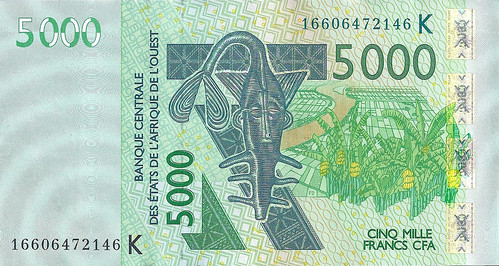
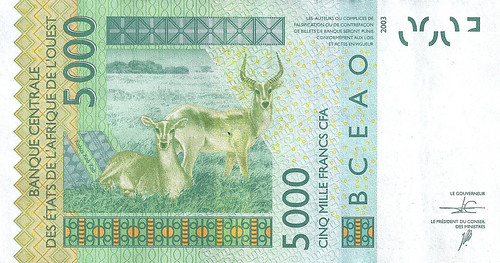
For more information on The Banknote Book, see:
http://www.banknotenews.com/banknote_book/banknote_book.php
WHAT IF COMPANIES PRINTED THEIR OWN CURRENCIES?
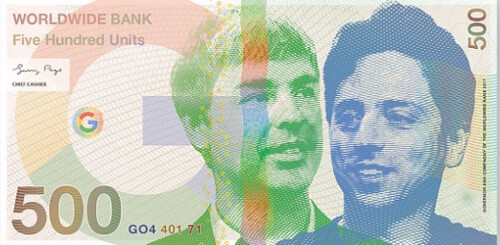
Google Founders Larry Page and Sergey Brin
Banknotes aren't really as distinctive or alluring as they once were.
Blame it on the advent of plasticization, single currencies or the rise of digital money. But many paper currencies remain deeply idiosyncratic, patriotic displays of the wealth and culture of a nation, adorned with great faces and timeless moments.
But what if banknotes came not just from countries, but companies as well?
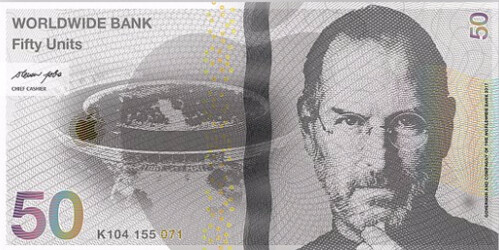
Apple Founder Steve Jobs
Many brands and corporations have greater GDPs, more assets and a higher headcount than some small countries -- so perhaps it makes sense for them to print their own money.
Graphic and motion designer Jade Dalloul has gone one step further, by imagining what these company-currencies might look like.

Facebook Founder Mark Zuckerberg
In a new set of illustrations entitled "Brand Currency," the French designer conjures up a future where the likes of Steve Jobs and Mark Zuckerberg have become the new Darwins and Franklins.
"Banknote aesthetics are really linked to the richness of culture, history and personalities of their countries," he said in an e-mail interview. Below, Dalloul discusses currency, capitalism and cash.
CNN: Jade, how did the idea come about?
Jade Dalloul: Seeing countries electing CEOs for presidents, and countries behaving like companies was the genesis.
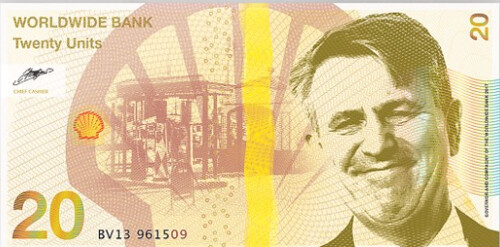
Shell CEO Ben van Beurden
CNN: How important is aesthetic in designing a banknote -- what is this visual language telling us?
JD: Banknote aesthetics are really linked to the richness of culture, history and personalities of their countries. On top of that, you have the anti-counterfeiting elements that take (up) a lot of space. CNN: This project is all about brands -- what role do you think brands play in modern society? Are they growing in importance?
JD: I'm a daily customer and a user of services and products like Facebook, Gmail and Apple, so I started asking myself if I could stand a single day without using any of these brands. It's getting more difficult day after day.
CNN: Which company or personality intrigues you the most?
JD: Answering the previous question, I had in mind Elon Musk. He has had a great career path, from Paypal to Space X through Hyperloop... and he's still only 46.
CNN: Are there any that you find particularly worrying?
JD: I'm both fascinated and worried about Google, because they manage almost every step of Internet services. But the most surprising fact is that they started only 19 years ago.
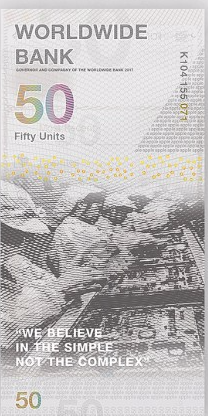
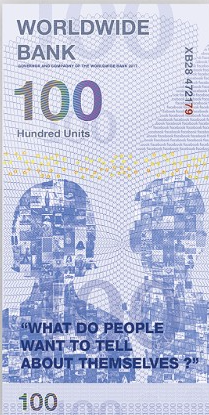
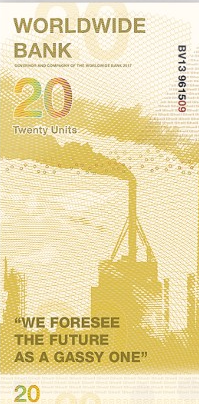
Apple, Facebook, Shell note backs
To read the complete article, see:
What if companies printed their own currencies?
(http://www.cnn.com/style/article/jade-dalloul-brand-currency/index.html)
FEATURED WEB SITE: INTERNATIONAL BOND & SHARE SOCIETY
This week's Featured Web Site is the International Bond & Share Society.Scripophily is the study and collection of stocks and bonds. Some people refer to scripophily as a specialized field of numismatics. Scripophily is an interesting area of collecting due to both the inherent beauty of some historical documents as well as the interesting historical context of each document.
Scripophily gained recognition as a hobby around 1970. The word “scripophily” was coined by combining words from English and Greek. The word “scrip” represents an ownership right and the word “philos” means to love. Today there are thousands of collectors worldwide in search of scarce, rare, and popular stocks and bonds.
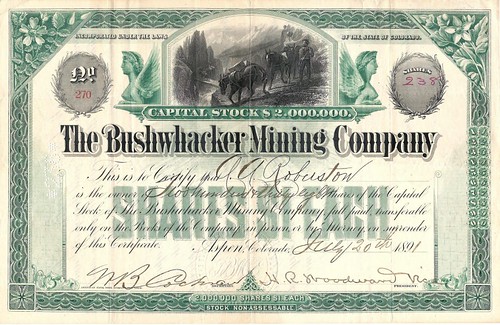
http://scripophily.org/

